




















Community first responders are celebrating the 20 th anniversary since the first CFR schemes were launched in 2005. CFR Ireland is now putting final plans in place for 'Respond 2025' conference on 27 September.
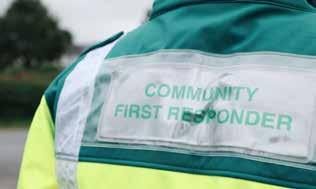
18
Dedicated to supporting and guiding emergency services and military personnel on the look-out to advance within their current roles, find new opportunities following retirement, or seeking totally new careers, Ireland’s only careers fair for frontline workers will take place on Friday 5 September in Athlone.
Response driving is frequently conflated with pursuit driving, according to D/Grada Mark Ferris, GRA Executive Member for Dublin West Division. He claims that until such time as the lack of pursuit training for members is addressed by An Garda Síochána, these policies will remain theoretical and expose everyone involved to high-risk situations.

One of two new Garda water cannon trucks and some new body armour for public order policing were introduced in June at the launch of the ‘Transforming An Garda Síochána’ report, which covers wide-ranging operational changes in the force over the last six years.
The cosseting of Irish citizens on security, defence and false neutrality truths have come back to haunt the Government and have led directly to the current Triple Lock debate debacle, writes Independent Senator Gerard Craughwell, a member of the Joint Committee on Defence and National Security.
A new training programme to improve the quality of CPR has been rolled out by the National Rehabilitation Hospital to help clinicians achieve and sustain high-quality CPR skills and competence, to result in improved outcomes for patients in cardiac arrest. 31 37 45

Northern Ireland Fire & Rescue Service has marked the official opening of its new state-of-the-art Learning & Development College, outside Cookstown, Co. Tyrone, followed by the graduation of its first cohort of full-time firefighters to complete the 19-week intensive training programme.
The National Ambulance Service decision to freeze the training of new advanced paramedics has only served to delay patient care and endanger lives, according to those on the frontlines of emergency medicine, who have outlined their concerns. 56



SUMMER 2025
www.emergency-services.ie
@EmergencyIrlMag
www.facebook.com/emergencyservicesireland
Medicall’s acquisition of Northern Ireland’s ambulance company Proparamedics is set to create the largest private ambulance provider in Ireland by offering an island-wide coverage across 12 bases, with a combined team of 320 medical professionals and support staff and a 70-strong fleet of vehicles, which includes 60 state-of-the-art ambulances.

An emphasis on alternatives to prison, outlined ‘Securing Ireland’s Future: Programme for Government 2025’, has been welcomed by the Irish Penal Reform Trust (IPRT). According to IPRT Executive Director Saoirse Brady, they’re encouraged to see an end to the government’s commitment to enact legislation extending the use of community-based sanctions.
Reforming the Road Safety Authority into two separate agencies has been the core recommendation of an independent external review and will change the co-ordination and implementation of road safety measures, as part of the second phase of the Government’s Road Safety Strategy (2021-2030).
Staff shortages are having a detrimental impact on patient care, as well as the health and wellbeing of nurses and midwives, according to the INMO. The union’s survey revealed that almost threequarters of its members claim that their workplaces do not have the right staffing levels and skills mix to meet patient demand.

Local authorities played a vital role in the response to Storm Éowyn earlier this year, which left thousands of people stranded without power many weeks later. In the aftermath of the worst storm to have these shores in recent decades, questions were raised about Ireland’s preparedness for such extreme weather events in the future.
Digital twin technology to improve real-time decision-making in emergency situations is undergoing a series of trials on DCU campus, before deployment across the wider area of Dublin City, and subsequently on a national scale.
85
The delivery of four new Airbus H145M helicopters for pilot training to support Defence Forces operations and the Garda Air Support Unit is due in the first quarter of 2027. The €91.7m contract, signed earlier this year by the Department of Defence, was awarded to Airbus Helicopters UK Ltd.
Last year was another busy and eventful one for the Irish Coast Guard. Throughout the year, it co-ordinated a total of 2,554 incidents which included search and rescue, maritime casualty responses and pollution and preparedness responses.
93
Three sisters from Tralee won the top prize at this year’s ‘BT Young Scientist of the Year’ for developing ACT (Aid Care Treat) – a smartphone technology project to greatly improve the response of the health services in emergency situations.
97
Forest wildfires have become more intense due to climate change, leading to human casualties and economic losses estimated at around €2 billion each year. However, while EU funding is increasingly used to finance prevention measures against forest fires, a new report reveals that the money is not always spent effectively on the ground.
PUBLISHER
Patrick Aylward
EDITOR
Grace Heneghan
GRAPHIC DESIGN
Niall McHugh ADMINISTRATION
Anne-Marie Moran CIRCULATION
Audrey Fitzgerald
Emergency Services Ireland, 14 Upper Fitzwilliam Street, Dublin 2
T: 01-6785165
E: info@emergency-services.ie W: www.emergency-services.ie
Whilst every effort has been made to ensure that the information included in correct, the publisher cannot accept responsibility for errors, omissions or discrepancies. The views expressed are no necessarily those of the publisher. All Rights Reserved Emergency Services Ireland © 2025
The Coast Guard reached another milestone in the transition of its Search and Rescue aviation contract from CHC to Bristow, with the Dublin-based helicopter service recently rolling out operations from Weston Airport.
The transition signifies the end of 27 years of Coast Guard helicopter services operating out of Dublin Airport. The new contract with Bristow includes the addition of fixed-wing aircraft, which will expand the Coast Guard's capabilities across areas such as environmental monitoring and aerial firefighting.
Sean Canney TD, Minister of State with responsibility for the Irish Coast Guard, thanked CHC Ireland, including their flight crews and support teams, for the service they’ve provided from Dublin Airport down through the years.
“CHC’s world class lifesaving operation has delivered an invaluable service to the Irish people. The Weston base will now provide Bristow Ireland with excellent facilities to enable them deliver safe and effective Coast Guard services,” the Minister noted.
Bristow flight crews have been conducting regular training on board the new Leonardo AW189 helicopters at the headquarters at Weston in advance of the rollout of the service. Initial operations are being carried out by a Bristow transition team who had managed the handover at the Shannon base.
The Dublin-based CHC staff who have transferred to
Bristow Ireland have started training on the new fleet of AW189 helicopters. The Weston-based AW189 helicopter, which replaces the Sikorsky S92 operated by CHC, will continue to use the call sign ‘Rescue 116’.
Meanwhile, the handover of the other bases at Sligo and Waterford airports is ongoing, with Bristow working with CHC to ensure a smooth transition.
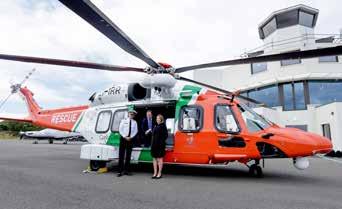
The first of six AW189 helicopters in the new fleet landed at Weston Airport in Dublin in August 2024, attended by (from left) Micheal O’Toole Director for the Irish Coast Guard; James Lawless TD, Minister of State at the Dept of Transport with responsibility for the Coast Guard; and Joanna Cullen, Assistant Secretary, Irish Coast Guard. (Pic: Maxwells)
The commitment to establish a Transport Security Force, as outlined in the new Programme for Government, has been widely welcomed by SIPTU as the union recently sought public feedback on anti-social behaviour across the transport network as part of its ‘Respect Transport Workers’ campaign.
Transport Minister Darragh O’Brien reaffirmed the government’s commitment to tackle the issue of anti-social behaviour, during a meeting of the Public Transport Safety Working Group in late March. The group includes representatives from the unions, the National Transport Authority (NTA), An Garda Síochána, the Department of Justice, in addition to passenger representative groups.
The creation of a Transport Security Force is seen as a strong commitment under the Programme for Government. It’s envisaged that the new force would operate in a similar manner, and have similar powers, to both airport police and customs officers.
The Department of Transport has started work to identify the necessary legislative proposals and alterations to enable the establishment of this force.
The Minister said that it remains “a high priority for Government” and highlighted the important role that the group will play in the planning and implementation of this commitment.

The new security force will play a central role in helping to tackle security incidents on the public transport network.

Ireland is set to provide €17.9m in funding to the International Red Cross and Red Crescent Movement, to support their humanitarian and life-saving assistance to people affected by conflict and disaster around the world.
In addition to supporting humanitarian work and lifesaving assistance, the funding will be used to reunite families separated by conflict and support locally led resilience to disasters and to the impacts of climate change.
The Irish Aid funding was announced by Tánaiste Simon Harris and Minister of State with responsibility for International Development and Diaspora, Neale Richmond. It brings Ireland’s humanitarian funding to the Movement to almost €21m in 2025, following a contribution of €3m in April to the IFRC Myanmar Earthquake Appeal.
The Tánaiste said that the International Red Cross and Red Crescent Movement provides a lifeline to people affected by humanitarian crisis around the world. “From providing life-saving assistance in conflict and disaster zones to fostering a culture of compliance with international humanitarian law, we know that we can rely on the Movement to deliver. This funding from Ireland will support work to bring assistance, protection and hope to people facing crisis around the world.”
Minister Neale Richmond added: “Armed conflict and other violence is exacting a horrific toll on people’s lives, while the number of disasters and climate-related shocks
continues to increase. The International Red Cross and Red Crescent Movement plays a vital role in delivering assistance and support to people who need it most. They act before, during and after disasters to meet the needs of the furthest behind and to build community and climate resilience in a world of increasingly complex humanitarian challenges.”
The €17.9m package includes €12m in core funding to the International Committee of the Red Cross (ICRC) and €5.9m to the International Federation of Red Cross and Red Crescent Societies (IFRC) – breakdown of €2m in core funding to the IFRC, €2.5m in support of the IFRC Global Climate Resilience Platform (GCRP) and €1.4m to support the IFRC Disaster Response Emergency Fund (DREF).

https://redcross.eu/about/international-red-cross-redcrescent-movement#page-body
Department of Defence has signed a contract for a new €53m aircraft to be used in missions across the globe, and with delivery expected this December, the government jet will be available in time for Ireland’s EU Presidency in the second half of 2026.
Following the deal for the French-made Falcon 6X, signed in December 2024, the then Tánaiste Micheál Martin, who was then also Minister for Foreign Affairs

and Defence, described this next generation aircraft as “a game-changer” for the State’s transport, airlift and medical capabilities.
Operated by the Irish Air Corps from Casement Aerodrome, Baldonnel, the jet will be used for a wide range of tasks, including the non-combatant evacuation of Irish citizens from critical situations, air-ambulance patient transfers, medical evacuation or repatriation of Ireland’s Defence Forces personnel deployed on overseas missions and logistics support for the transport of supplies to Irish Defence Forces overseas missions.
Manufactured by Dassault Aviation SA (French aerospace company of long standing in the aviation and defence industries), the Falcon 6X will have a total seating capacity of 17 persons and a passenger capacity of 14. The airframe is being built in the company’s production facility in Bordeaux, France.
With a maximum range of 5,060 nautical miles, the multi-purpose strategic reach aircraft can reach the west coast of the United States without the need to refuel. It features a modern suite of avionics, secure communications, operational and safety equipment. The cost of the Falcon 6X aircraft is just below €53 million (plus VAT).

The Department of Health and the Health Service Executive (HSE) launched the first version of the new HSE Health App earlier this year, which provides patients with easy access to their health information.
Health Minister Jennifer Carroll MacNeill described the app as an “exciting milestone” where patients now have digital access to their own health information and will make it easier for everyone to navigate the health service.
“We can now ensure that every patient is provided with easily accessible health information that is accurate and trustworthy. The phased introduction of appointment notifications and reminders will make it easier for people to manage their care.
“The App development team have also consulted with a number of patient organisations so that their needs are incorporated into the design process to ensure the App is patient centred.” The HSE is working with colleagues across government to integrate the HSE Health App with the Government Digital Wallet that will be released later this year.”
The HSE Health App is built with the highest standards of security and privacy, ensuring that patients' personal health information is protected, and designed to provide a simple and secure way for

The HSE Health App will be integrated with the Government Digital Wallet, to be released later this year, according to Health Minister Jennifer Carroll MacNeil, on launching the app earlier this year.
patients to check out their personal health information, have control over their health management and access to information sources like HSE Live.
The app also provides access to public hospital and screening appointments information; referral check-ups and waiting times information and receive additional self-care information and support services including smoking cessation and chronic disease management. For more information visit www.hse.ie/health-app
‘BILL
Aproposed Road Traffic and Roads (Blood Bikes Exemption) (Amendment) Bill 2025 by Sinn Féin TD Aengus Ó Snodaigh would extend exemptions from road tolls and the right to use bus lanes, which currently apply to ambulances, to Blood Bike services.
For years, the provision of vital emergency healthcare in Ireland has relied, in part, on volunteers who operate rapid response motorbike-based courier services free of charge for healthcare facilities in the form of blood bike groups, according to the Sinn Féin TD.
“This work includes the transport of blood, platelets, medicinal samples, surgical instruments, human donor milk and other clinical products to hospitals, medical centres, nursing homes, general practitioners and other healthcare facilities and contexts.
“However, these volunteers face being penalised for fulfilling this lifesaving work, as they have to pay road tolls for transporting blood and other clinical essentials to where they are needed.
“Ambulances are exempt from road tolls and may also use bus lanes and other restricted traffic areas, under an exemption provided in existing road traffic legislation. My Bill would expand the exemptions currently provided to ambulances to also apply to blood bikes.”
This follows a previous Bill O’Snodaigh said he brought forward in 2017 to expand the exemption to sea and river rescue teams, including the Coast Guard, Civil Defence and the RNLI.
“It would put Ireland in line with international best practice, such as the exemption from road tax provided for blood bikes by the British Government. It’s a simple initiative to help volunteers continue to save lives, and I hope the government will support it to pass into law. This marks the fifth piece of legislation I’ve introduced in the first few months of this Dáil term to offer commonsense solutions to problems that can easily be solved if the government is willing to act.”


When we speak of creating or developing an attitude of mind, we are landed in the field of education. What then are we to understand by the word ‘education’ in the context of road safety or collision prevention? It surely implies correct information, tuition, and training for everyone that forms part of the stream of movement on our streets and roads. Applied to road safety we would endeavour to define education as the imparting of knowledge with a view to creating or developing an attitude of mind about driving that will manifest itself in agreement with what has been learned and driving behaviour that reflects the attitude.
Information on road safety initiatives such as the Emergency Services Driving Standard (ESDS) must be communicated to all who are affected: but information even when adequate and concise in form, may not be enough; the trainers and drivers must grasp at least some of the reasoning that lies behind the initiative. Failing to understand the core elements of ESDS the trainers and drivers will not develop a proper attitude and their behaviour may continue to be irresponsible.
The objective of the ESDS is to educate people in road safety, to develop in the individual an attitude of mind and a sense of personal responsibility not merely for their actions but also for the consequences of their actions.
It is important to point out that a multi- disciplined approach is needed: for example, information that is absorbed as knowledge must be put to work while behind the wheel and training in personal responsibility must be accepted.
The ESDS initiative is a large and significant investment in Road Safety in Ireland. ESDS using the System of Vehicle control as detailed below will not only educate our emergency services drivers in relation to collision prevention but will also instill the understanding of what collision prevention means - the object of educating is not so much to protect them from danger continually, as to enable them to live in a dangerous world without losing their enjoyment of driving . Such an attitude is educational in outlook.
A total of 7,821 (January 2025) emergency service drivers have been certified to the higher Emergency Services Driving Standard (ESDS) since the initiative was introduced in 2014.
TThe 2025 recruitment campaign for the Irish Prison Service (IPS) aims to attract 300 new recruits, with applications to remain open until 1 August.
The campaign, in conjunction with a unique virtual prison tour, was launched in early July by Minister for Justice, Home Affairs and Migration Jim O’Callaghan. The tour is a new web-based innovative tool that allows visitors, service users, and the wider public to see inside an Irish prison, guided by a digitally created prison officer. This project aims to increase public understanding of how Ireland’s prisons operate on a day-to-day basis.
Minister O’Callaghan said that this year’s recruitment campaign is a key part of a much wider investment by government in the Irish prison system. “The Government is committed to ensuring that all prison officers are enabled and equipped to do their jobs to a high standard in a workplace where they feel safe and protected,” he noted.
Caron McCaffrey, IPS Director General, described the recruitment campaign as “a vital opportunity to attract individuals who are committed to public service and rehabilitation, and who will play a central role in maintaining safe and secure prison environments”.
She noted that the annual recruitment competition coupled with the launch of the virtual tour provides the Irish Prison Service with “an opportunity to let the public

see the teamwork, integrity, potential, safety and support that prison officers not only offer to prisoners, but to their colleagues as well”.
Eligible candidates will undergo a comprehensive selection process, including written assessments, physical fitness tests, interviews, and background checks. Successful candidates will receive extensive training and mentorship to equip them with the necessary skills and knowledge required for the role.
Prison officer training is accredited by South-East Technological University (SETU) as the Higher Certificate of Arts in Custodial Care. SETU was formed with the amalgamation of Waterford IT and IT Carlow.
Last year’s recruitment campaign attracted more than 1,500 applicants resulting in 271 prison officers joining the service.
Marking 75 years of Civil Defence in Ireland, President Michael D. Higgins hosted officers and volunteers from Civil Defence units nationwide at Áras an Uachtaráin in May and paid tribute to their service.
“Whether it be through its service in medical rescue, search and rescue, emergency response, radiation monitoring, or community assistance, the Civil Defence volunteers have shown, time and again, their dedication and response capability in support of the primary emergency services and their local communities,” President Higgins noted. He commended all members, past and present, for this work and for their spirit of volunteerism, giving back to their local community and indeed to wider society.
The Civil Defence, organised on a local authority basis across the State, was first established by the Government in December 1950, in preparation for a potential nuclear war which was then seen as distinctly possible. At that time, the emphasis was on war response, including search and rescue, medical first aid, and welfare through rest centres.
Today's Civil Defence has evolved into a professionalised volunteer service, specialising in the use of drones and thermal cameras for search and rescue, and operating a modern fleet of response vehicles and boats. The organisation supports the principal response agencies in a variety of emergency and non-emergency
duties, including medical response and extreme weather response.
Across the country, Civil Defence supports more than 3,000 duties every year. Many of the non-emergency response duties are in support of local communities. To ensure it can continue to serve local communities, Civil Defence needs volunteers from all communities and is actively recruiting across the country for a range of skillsets.
The event at the Áras was the first of several events to commemorate this anniversary and to recognise the commitment of volunteers over the years.



Community first responders are celebrating the 20 th anniversary since the first CFR schemes were launched in January 2005, and now CFR Ireland - the National First Responder Network - is putting final plans in place for its ‘Respond 2025’ conference, which takes place on 27 September in Mullingar.
The last 20 years have seen major changes to community first responding in Ireland, with advancements in CPR and AED training programmes and assessments for community first responders, coupled with an increase in the number of CFR groups now linked up with the National Ambulance Service.
At the end of 2005, just over 20 CFR groups were linked to the National Ambulance Service (NAS). In 2014 there were 63 Community First Responder (CFR) schemes

in Ireland and today there are over 350 CFR groups in operation, with all volunteers linked to the NAS.
On looking back over the last two decades, John Fitzgerald, Chair of CFR Ireland, tells ‘Emergency Services Ireland’ that the very first Community First Responder (CFR) information meeting was held in Shillelagh, Co. Wicklow in August 2004.
“The meeting, which was attended by over 200 people, was organised by local Fine Gael TD Billy Timmins in conjunction with Advanced Paramedics from the HSE National Ambulance Service – Shane Mooney and Richard Shannon.”
RESPOND 2025 RETURNS ON SATURDAY 27 SEPTEMBER Respond 2025 – the conference and exhibition organised by CFR Ireland for community first responders – returns to the Mullingar Park Hotel on Saturday 27 September.
“Respond 2024 was our 10 th and largest conference to date and was attended by up to 550 delegates from all parts of Ireland,” noted John Fitzgerald, CFR Ireland Chair. He said that having reviewed the feedback from the ‘Respond 2024’ survey, “we will develop and resource new workshops to add to the popular selection”.
Registration for the conference is due to open in the next few weeks. The National Ambulance Service, Pre-Hospital Emergency Care Council, Irish Heart Foundation and many more similar stakeholders will once again be there to support Respond, while major first aid and AED equipment suppliers will also showcase their latest range of products and equipment for CFR groups.


























PROUDLY SUPPORTING BOTH OUR NATIONAL TEAMS





































































There have been major advancements in CPR and AED training programmes for community first responders in Ireland.
REMEMBERING ‘THE GODFATHER OF CPR’ Reflecting over the last 10 years of Respond, John Fitzgerald said that while there have been many highlights, the most memorable was when Professor Douglas Chamberlain addressed the ‘Respond 2015’ conference, held in Tullamore, Co. Offaly.
“He was due to attend our first conference in 2014 but having injured his ankle he could not travel from the UK. However, he had requested to attend the event the following year and the rest as they say is ‘Respond history’,” Fitzgerald recalls.

“Over the following years, we were very fortunate to meet the ‘The Prof’ on several occasions and to hear him speak. A huge supporter of community response, he was known as the ‘Godfather’ of CPR. He shared with us a number of what he called his ‘laws’.
“He wanted to bring CPR to the masses and demystify the use of AEDs. One of his laws was – The only damage you can do to someone with an AED, is if you whack them around the head with it. Prof Chamberlain, who passed away in May of this year, has left a legacy that will not just impact the UK and Ireland, but Europe and across the world. A true legend. Go raibh dea-shúil de ar a anam.”
Prof Chamberlain’s keynote presentation at Respond 2015: https://youtu.be/ETqpShbnQK4?si=FUa9AGN-u3iYH60G
He recalls that over the course of the following months, information nights were held across Co. Wicklow and parts of next-door neighbour Kildare, e.g. the first Dunlavin CFR information night was held in in November 2004.
“The first CFR groups were established in parts of Wicklow and Kildare from January 2005 onwards, with the first training programme held on 12 and 13 February that year provided by instructors from the National Ambulance Service.
“Community First Responders (CFRs) from Dunlavin, Hollywood, The Glen, Donard and Rathdangan. CFRs were taught American Heart Association (AHA) Heartsaver CPR and AED for adults, children and infants, and the use of oxygen therapy for chest pain management.”
Recommendations by the International Liaison Committee on Resuscitation (ILCOR) had not been introduced in 2004, with CPR delivered at a just a rate of 15:2 compressions to breaths. However, when the ILCOR recommendations were introduced the following year, this ratio saw an improvement when all CFRs were upskilled to 30:2 compressions to breaths during the autumn of 2005.


Fitzgerald pictured with members of the Community
and surrounding area at a previous Respond event.
Lookback to 2005 and what followed….
• Initial training of Community First Responders (CFRs) took place over two days.
• CFR volunteers were trained by paramedics and advance paramedics from the National Ambulance Service.
• CFR volunteers had to ‘recertify’ every 90 days.
• The National Emergence Operations Centre (NEOC) was not established at that time, and call centres were used instead. CFRs were notified of emergencies by phone call (there were no smart phones in 2005!).
• The PHECC Cardiac First Responder Community launched in 2006 and was rolled out in 2007.
• In 2005, the survival rate for out-of-hospital cardiac arrest was estimated at 1%.
• The Out-of-Hospital-CardiacArrest-Register (OHCAR) was established in June 2007.
• In 2023, the survival rate had substantially increased to 8.4%. (OHCAR 2023).
The PHECC Cardiac First Responder Community training standard was implemented in October 2007, which subsequently allowed for aspirin therapy and FAST assessment to be included in CFR training skills.
The first CFR groups from Roundwood, Moneystown and Laragh in Co. Wicklow went live with the National Ambulance Service (NAS), quickly followed by several other communities across Wicklow
covering
and Kildare. At the end of 2005, over 20 CFR groups were linked to the National Ambulance Service.
“Dunlavin CFRs went ‘live’ with the National Ambulance Service on 4 April 2005. Dunlavin’s first response call for CFRs was to an incident of ‘chest pain’ at 1:05am on 16 February 2006. There was no text messaging at that time and CFRs were dispatched by telephone call from local NAS stations, Wicklow Town and Naas. Smart phones were not a thing in 2005!”

Prof Doug Chamberlain – known as the ‘Godfather’ of CPR – shared several of his ‘laws’ during his keynote address at ‘Respond 2015’ in Tullamore, Co. Offaly.

This heart-thumping moment of pride, brought to you by a timely intervention from our 24/7 Urgent Cardiac Care service.
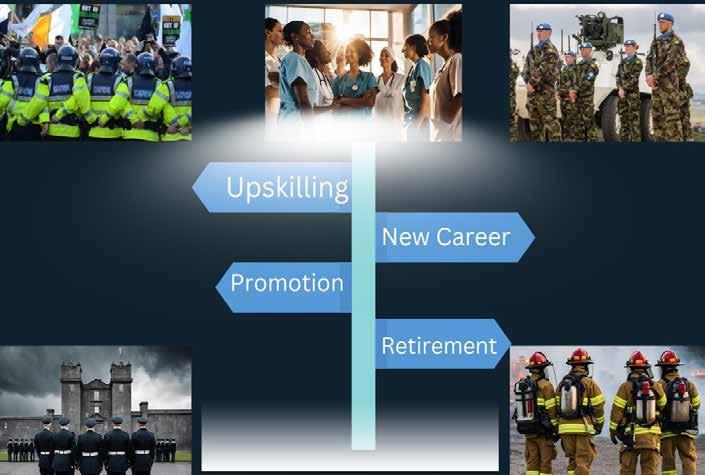
Dedicated to supporting and guiding emergency services and military personnel who may be on the look-out to advance within their current roles, find new opportunities following retirement, or seeking totally new careers, ‘Out of the Blue Career Horizons Expo’ will take place on Friday 5 September at the Radisson Blu Hotel in Athlone.
Since the first event was held in April 2024, the ‘Out of the Blue Emergency Services & Military Expo’ has become an invaluable resource for Ireland’s dedicated service members as they navigate their next career steps, according to Stephen Moore, who founded Out of the Blue Training & Employment Services in late 2023.
The former Garda has 20 years of experience working in An Garda Síochána, where he trained over 2,000 Gardaí on interview techniques.
A former Divisional Representative with the GRA, Moore is “passionate about helping members of the emergency services and the defence forces to transition to new careers”.
He said he understands that leaving or retiring from the
emergency services or military can be a “daunting task” and added that he is committed to providing these individuals with the support and guidance they need to succeed.
His company’s fourth ‘Out the Blue Careers Horizons Expo is now set for 5 September in Athlone, following the first three successful events held in April and November 2024, and most recently on 4 April at the RDS.
“It stands as the nation’s sole event specifically designed to support the brave men and women who serve their country across the emergency services and military sectors. This event in Athlone promises to offer an even more comprehensive experience.
“A highlight of the expo is the

Behan Aggregates and Recycling Ltd is a well established, family run business of a third generation. Located in Rathcoole County Dublin, we have the ability to produce over 5,000 tons of quality stone and asphalt per day.
We supply a range of products for the building trade including Quality Asphalt and Tarmacadam, High Quality P.S.V Chippings, Granular Sub-Base Material CL 803/4/8, Hardcore Fill (All Grades) products. We are constantly improving our standards to maintain a high quality in service and product. We stock various types of building stone as well as our range of chipping and pebbles.
Manufacturers in the extractive industry supplying raw materials to the civil and construction industries. The development of our own distribution of modern trucks and plant enables us to provide an efficient, fast and reliable service in the most demanding of delivery schedules.
Our high quality products can be used to meet most of the new requirements, however our prices remain competitive. Our aggregates carry the CE mark and Declarations of Performances for every grade of aggregate or fill material. All our stone products are pyrite free.
Suppliers of
• Quality Asphalt & Tarmacadam
• High Quality P.S.V. Chippings
• Granular Sub Base Material
• Hardcore fill (All Grades)
Lord Mayor of Dublin Emma Blain, who officially opened the 'Out of the Blue Careers Expo' at the RDS on 4 April 2025, is pictured with:


, who founded
Training & Employment Services'' in late 2023, and launched the first careers expo in April 2024.




















































































































































opportunity it presents to attendees to receive free career guidance from a host of superb career coaches, offering personalised support at every stage of a service member’s journey,” he added.
He said that the event will offer delegates a range of “insightful keynote speakers and engaging panel discussions”, covering topics such as health and wellbeing, upskilling opportunities, transitioning from service and essential financial advice. A dedicated Q&A session will also provide a platform for interaction with both serving and retired members, alongside industry leaders and educational institutions.
“This Athlone Expo promises to be an even more comprehensive

RECRUITMENT PLATFORM FOR EMS AND MILITARY PERSONNEL
‘Out of the Blue Recruitment’ will be officially launched at the Athlone Expo on 5 September. Dedicated solely to frontline workers considering a full career change, exploring options for later in life, or simply curious about what is out there, this recruitment platform will be available to connect them with suitable employers.
“Employers already trust the professionalism, teamwork, and resilience that come from years on the frontline. Now it’s time those qualities opened new doors for you. Out of the Blue Recruitment is more than just job listings. It’s about finding roles that fit who you are – not just what you’ve done,” according to a preview on the company’s website. For further information email info@ outofthebluetraining.com
experience, catering to a diverse audience including those considering a career in service, individuals seeking advancement within their current roles, those planning their transition into retirement, or seeking new careers,” according to Stephen Moore.
Meanwhile, up to 50 exhibitors will be showcasing an array of services.
“These include companies actively seeking to hire former service personnel, financial institutions offering tailored advice, government agencies, in addition to numerous educational institutions presenting free and heavily subsidised courses. Health and wellbeing experts will also
be on hand to provide vital support.” Added to the agenda this time around, ‘Out of the Blue Recruitment’ will be officially launched at the expo in Athlone. This new initiative will allow service members who are on the look-out for post-service career opportunities to sign up on the day, further streamlining their transition into civilian life.
“So, whether you're contemplating a career in uniform or nearing the end of your dedicated service, the ‘Out of the Blue Emergency Services & Military Expo’ is an unmissable event. It offers a unique and invaluable opportunity to gain guidance, explore new possibilities, and connect with a supportive community,” Moore concluded.






Response driving is frequently conflated with pursuit driving, according to Detective Garda Mark Ferris, GRA Executive Member for the Dublin West Division. He claims that until such time as An Garda Síochána addresses the lack of pursuit training for members, these policies will remain theoretical and expose everyone involved to high-risk situations, not to mention representing a major risk to the public.
There has been recent public commentary around the updated pursuit policy of An Garda Siochana by the national broadcaster RTÉ. Commissioner Drew Harris has said: "Gardaí can now pursue people driving scramblers, scooters and electric bikes in a dangerous fashion, which they (Gardai) had previously been forbidden to do”.
He added that “the previous policy has been changed and these drivers, mostly young men wearing face coverings and not helmets, can be apprehended through pursuit and vehicle-stopping devices”, whilst finally saying of Garda members that “when it’s appropriate and proportionate to the threat, they can pursue”.
I feel this commentary requires some background and context, given the advocacy role of the Garda Representative Association (GRA) on behalf of our members. It is especially important given the
often contentious – and occasionally highly controversial – nature of this aspect of police work.
High speed pursuits of reckless criminals are regular fodder for the media and the decisions of officers on the ground in exceptionally challenging circumstances are subject to the hindsight of commentators who will never have to make these decisions. That is why it’s important to look at this ‘policy change’ and its implications for Garda members.
The old policy set out in HQ Directive 44/19 (‘Managed containment and stopping of subject vehicles’) and the newer policy in HQ Directive 87/24 (‘Spontaneous Pursuit’), which replaces the older one, share identical foundational principles: proportionality, necessity, and accountability under the European Convention on Human Rights (ECHR).
The rebranding of terminology (e.g., ‘managed containment’ to ‘spontaneous pursuit’) does not constitute any substantive or meaningful policy change.
Key operational parameters – risk assessment, supervisory oversight, and containment processes – remain consistent across both documents. The perceived ‘change’ or shift reflects the confusion between organisational policy (written directives set out) and organisational practice (implementation of same).
These are the critical deficiencies that undermine the newer policy:
• Control Room Authorisation: Directive 87/24 mandates supervisory oversight for pursuits, yet control room personnel lack standardised training in dynamic risk assessment, pursuit initiation or termination criteria, or indeed ECHR compliance. This violates the policy’s requirement for ‘qualified oversight’ and makes the authorisation of a so-called pursuit potentially a violation of the policy itself.
• Pursuit Driver Training: There is no member of An Garda Siochana trained and appropriately authorised in pursuit driving which renders the policy inoperable. Competency
Based Driving 2 (CBD2) drivers (which make up the vast majority of response drivers) are not trained in any element of pursuit.
Response driver training, as governed by the Emergency Services

Driving Standard (ESDS) in An Garda Síochána, is frequently conflated with pursuit driving, highlighting a misalignment between organisational policy, operational implementation and public messaging. Driving to an emergency situation such as an armed robbery in progress with blue lights and sirens on is not, and should not, be confused with pursuit driving.
Pursuit Driver Training, as defined by the College of Policing, the professional body for those working in policing in England and Wales, identifies the following situations:
1. When a driver/motorcyclist indicates by their actions or continuance of their manner of driving/riding that they have no intention of stopping for the police.

The new standard was rolled out by the RSA to ensure Gardaí, ambulance and fire services personnel were more aware of risks associated with driving emergency service vehicles.
2. The police driver believes that the driver of the subject vehicle is aware of the requirement to stop and decides to continue behind the subject vehicle with a view to either reporting its progress or stopping it.
While pursuit driving requires active evasion and awareness of a driver's refusal to stop it also requires a level of competence to engage, while response driving is a distinct driving activity that allows trained members, for example under CBD2, to exceed normal driving standards when responding to emergency incidents.
These fundamental differences highlight how the two activities should never be confused or conflated. In fact, the College of policing also says of pursuits if ‘the situation falls within the definition of a pursuit, and non-pursuit trained drivers must discontinue immediately.’
On closer view, the entire CBD driver training model also has NO element of pursuit driving incorporated across any of its facets. Tactical vehicle containment or the use of vehicle stopping devices do not constitute pursuit driving techniques or the required level of competence with which to engage in pursuit driving.
For additional context, the UK's College of Policing's pursuit framework explicitly stipulates that all personnel involved in pursuit management, including control room staff, tactical advisors, and drivers, MUST undergo standardised training aligned with NPCCapproved standards.
Representatives from the principal response agencies, pictured with Moyagh Murdock, RSA Chief Executive (centre) at the launch of the Emergency Services Driving Standard (ESDS) on the grounds of Farmleigh House on 18 November 2014.

This is not advisory but a foundational governance requirement for lawful, safe pursuits in that jurisdiction. In light of this, I contend that the absence of a training framework-aligned programme invalidates Directive 87/24s operational viability. Pursuits cannot be safely authorised or conducted under these conditions.
To allow these pursuits magnifies the risks to the health and safety of rank-and-file Gardaí and jeopardises their career trajectory with the potential for disciplinary, or even legal action, in the event of a mishap.
Thus, the purported policy “change” is purely semantic and not substantive. The remedy is simple but challenging and requires leadership – a comprehensive review of the current pursuit driving landscape.
And following this the appropriate, and if required, investment in a training framework that is designed to create pursuit programmes and also identify and upskill all members who could likely engage in this hazardous policing activity.
So, until An Garda Síochána addresses this lack of training, pursuit policies will remain theoretical and expose everyone involved to high-risk situations. Inadequate or no training results in individuals making poor decisions or worse again no decisions. The risk to the public is great in situations where people are not equipped appropriately to deal with dynamically unfolding events.
Detective Garda Mark Ferris is based in Blanchardstown Garda Station and has over 24 years of frontline experience, including more than 20 years as a response driver. He is an executive member of the Garda Representative Association (GRA) for the Dublin West Division.
A passionate advocate for his colleagues, D/ Garda Ferris has developed strong identification and negotiation skills and a proven track record of delivering decisions that enhance conditions and welfare within the service. He holds a Master’s Degree in Human Rights, a Higher Diploma in Leadership, and a Law Degree in Applied Policing.






Proud to Support the Emergency Services

















Full time 24/7 care
Dementia & Alzheimer Care
Companionship
Assistance with daily activities
Support with a disability



Respite Care
Recovering from an illness
Support during an illness
Palliative Care


In light of this, the following recommendations should now be made by the GRA:
Independent Review: An immediate suspension of Directive 87/24 pending examination by an independent review body that can make appropriate training framework recommendations. These recommendations should accurately reflect and align current practice with organisational policy.
Training Framework Audit: This review should include an audit of existing response driver training and also examines best practice evidence from other jurisdictions. Appropriate recommendations around alignment such as with the College of Policing/NPCC benchmarks should be made.
Public Messaging: Clarify public messaging to distinguish policy terminology from operational reality. i.e. response driving (blue lights and sirens) is not pursuit driving.
These recommendations require leadership, but it should also be noted that leadership is not just about being in charge. It’s also about taking care of the people in your charge. This pertains to the CEO of any organisation, public or private sector and An Garda Siochana should be no different.

1. ESD Level 1 is the entry level and sets out the training, learning and assessment to produce competent and responsible emergency service drivers.
2. ESD Level 2 describes the training, learning and assessment for emergency service drivers and includes the principles and skills set of ‘Roadcraft’ (a system of vehicle control in training emergency service drivers that develops a methodical and systematic approach to driving). The system increases safety by giving the driver more time to react in complex situations as they have a greater awareness and ability to anticipate hazards.
3. ESD Level 3 refers only to services who by law can drive using blue lights and sirens in emergency response situations when this does not endanger the safety of other road users. An example of this is when an emergency services vehicle exceeds the statutory speed limit. This applies only to those emergency services specified in Section 87 of the Road Traffic Act 2010 – such as An Garda Síochána, Ambulance Services and Fire Services.
The Emergency Services Driving Standard (ESDS) was officially launched by the Road Safety Authority (RSA) in November 2014. The standard – the first one of its kind in Europe – was then rolled out by the principal response agencies in 2015.
The driving standard for emergency services – as identified in the Government's Road Safety Strategy 2012-2020 – was developed by a working group with representatives from the RSA, the Chief Fire Officers’ Association, HSE Ambulance Service, An Garda Síochána, Civil Defence, Irish Coast Guard, Defence Forces, Irish Prison Service, the Pre-Hospital Emergency Care Council, and the National Directorate for Fire and Emergency Management.
Speaking at the launch of the ESDS, RSA Chief Executive Moyagh Murdock said at the time that the standard and syllabus was “developed in response to the need identified by many emergency service professionals for training and management, when driving in complex and stressful emergency response situations”.
She said that the aim of the RSA was to ensure that the emergency services drivers had “greater confidence of dealing with particular risks associated with emergency response driving, and that they will also be better equipped to react to the countless hazards that they have to deal with on a daily basis”.

was the cover story in ‘Emergency Services Ireland’ (Issue 50; December 2014).





Gardaí introduced one of their two new water cannon trucks at Garda HQ, in addition to some new Garda body armour for public order policing duties, at the launch in early June of a six-year report on advances made by An Garda Síochána to modernise the force since it first started implementing the new plan in 2018.
Garda Commissioner Drew Harris first signed off on the purchase of the two water cannon trucks in September 2024 as part of the recent expansion of Garda fleet of vehicles. The water cannons were first delivered in January 2025, and one was on display at Garda HQ on 9 June during the launch of the ‘Transforming An Garda Síochána 2018-2024’ report.
According to the report, a wide range of significant changes have been rolled out; over 15,000 mobility devices have been issued to Gardaí,
while 700 body worn cameras are also being piloted.
Significant investments have been made over the last two years in the procurement of additional personal protective equipment for Gardaí, including incapacitant spray with greater potency and upgrades to body armour and defensive equipment available for Public Order Units.
The Garda fleet at 3,672 vehicles – including the two water cannons, ASU vehicles, Public Order and Community Engagement vans – is
the largest it has ever been, and the report also notes that public trust in the force stands at 89%.
It was compiled to provide an organisational account of the implementation of the ‘A Policing Service for Our Future’ programme in An Garda Síochána, a key recommendation of which was the delivery of the Garda operating model.
The operating model has been rolled out to all 21 Garda Divisions and represents the biggest structural change to the organisation. It has







One of two new water cannon truck was on display at Garda HQ in early June – each truck has the capacity to carry 5,200 litres of water. (Pic: David Mac Redmond, Journal.ie)
established four functional areas within each division, community engagement, performance assurance, crime and business services functions.
Garda Headquarters claims the operating model serves to enhance the service it provides to the public, particularly the most vulnerable in society.
According to ‘Transforming An Garda Síochána’ report: “The acute risks of physical harm and psychological trauma that members of An Garda Síochána face in carrying out their duties remains a core concern for the organisation”. The continuous need to protect, support and care for our personnel has been the basis for an extensive, cross-service investments in recent years,” it said.
Since the Dublin riots of November 2023, Gardaí said that significant investments have been made in personal protective equipment (PPE) for members of the Force. Those include new incapacitant spray and upgrades to body armour and defensive equipment now available for public order units.
“This includes new shields, helmets, torso protectors and limb guards designed to protect gardaí involved in the policing of riots and significant public order incidents from blunt impacts, stabbing implements, flames and accelerants,” the report said.

The Irish Council for Civil Liberties (ICCL) has welcomed the publication of the Garda report of its progress on reforms since the recommendations were made by Commission on the Future of Policing (CoFPI) 2018 but cautions that “the journey of reform is far from over”.
After what An Garda Síochána acknowledges in the report were “significant challenges to its reputation and credibility” following a series of scandals, human rights are now officially recognised as the foundation and purpose of Irish policing.
In 2024 ICCL published an independent review of progress on CoFPI implementation and found outstanding concerns regarding accountability, transparency and the effectiveness of police oversight bodies to hold An Garda Síochána to account.
ICCL has previously cautioned that the Policing, Security and Community Safety Act 2025 only partially implemented the root-and-branch reforms recommended by CoFPI. Joe O’Brien, Executive Director of ICCL, said the report highlights a lot of progress made by An Garda Síochána to improve policies and strategies.
However, he said it is also necessary to look at how these changes are being implemented in practice, and claimed that on moving forward, rigorous monitoring will be essential to ensure ongoing progress and accountability.
“Members of the public have recently expressed concern to ICCL about the policing of protests in Dublin and Shannon, including the disproportionate use of force against peaceful protesters. ICCL will continue to monitor the policing of protest as a key area in which we see unacceptable interferences with human rights.
“The government’s stated plans to introduce facial recognition technology into Irish policing risks exposing the public to indiscriminate surveillance and misidentification, and damaging the Garda’s relationship with the public, which has been long built on its community policing model."

While the report highlights a lot of progress made by An Garda Síochána to improve policies and strategies, it is necessary to look at how these changes are being implemented in practice, according to Joe O’Brien, Executive Director of ICCL.


Reduce your carbon emissions with sustainable transport solutions. They not only enhance your brand image but also offer a quieter, smoother, and more comfortable driving experience for drivers.


The Renault Trucks E-Tech range now covers 3.1 to 44 tonnes. Its modular battery system lets customers tailor battery capacity to balance range and payload, making it a highly versatile lineup.
Renault trucks can offer you customised finance solutions for your Heavy & Light commercial vehicles. With our finance solution, your credit lines with existing funders, will be preserved. Contact our team today to find the best deal for you.



The report was compiled to provide an organisational account of the implementation of the ‘A Policing Service for Our Future’ programme in An Garda Síochána.

Garda Commissioner Drew Harris first signed off on the purchase of the two water cannon trucks in September 2024, which were then delivered to Garda HQ in January 2025
AGSI CALLS FOR INCREASE TO 18,000 IN GARDA NUMBERS
The Association of Garda Sergeants and Inspectors (AGSI) had claimed that with Garda numbers stagnating and dissatisfaction rising across the force, there is need for urgent action, and is calling for an increase in Garda numbers to 18,000 to both serve an increasing population and prevent a policing crisis.
AGSI and inspectors attended the Joint Oireachtas Committee on Justice, Home Affairs and Migration on 17 June, to highlight issues around recruitment and retention, the Operating Model, and the erosion of community and roads policing.
AGSI recognises the dual role of An Garda Siochana as Ireland’s Policing and National Security Service and recognises the work done by Government and the Minister for Justice in strengthening national security but with the evolving international landscape, the Association is now calling on Justice Minister Jim O’Callaghan to continue his work in strengthening resources and legislation in this area.
AGSI’s key points at the Joint Oireachtas Committee meeting:
Recruitment and Retention: This remains a significant challenge for An Garda Síochána. Difficulties experienced securing new entrants and retaining members have been frustratingly consistent over the last five years, with numbers hovering either side of the 14,000 mark.
Operating Model: A significant portion of AGSI’s submission was devoted to the “unworkable” Operating Model implemented by Garda management and government. Adapted from international policing systems, the model has failed to account for Ireland’s unique geography and ruralurban dynamics.
Gardaí on the ground report increased administrative burdens, confusing responsibilities, excessive centralisation, and the disappearance of key leadership roles from local areas. Officers report a decline in service quality and visibility, and our members are worried that it’s not serving the public well. There’s a significant and growing frustration in the AGSI that we are not being listened to.
Community Policing: Gardaí permanently assigned to community roles have dropped from 807 in 2015 to just 697 today. Officers in these roles are frequently redeployed to fill gaps in other units, undermining trust-building efforts and local engagement. Community Gardai interact with all their local community partners such as businesses and residents whilst also engaging with an array of community services.
Roads Policing: The Association is calling for a national road safety strategy that blends strong enforcement with public education and cross-agency collaboration. Roads Policing Units (RPU) have seen their numbers drop by 41% over the past 15 years, from 1,046 officers in 2009 to just 620 in 2024. AGSI welcomes increased investment in technology and vehicles, yet issues such as staff abstraction, a lack of enhanced training, and low morale continue to obstruct progress.
In its concluding remarks to the Committee, AGSI warned that without decisive and meaningful reform, Gardaí may struggle to meet the most basic expectations of public safety and community engagement in the years ahead.

Ronan Clogher, AGSI General Secretary, addressed the meeting on 17 June.





The cosseting of Irish citizens on security, defence and false neutrality truths have come back to haunt the Government and have led directly to the current Triple Lock debate debacle, writes Independent Senator Gerard Craughwell , a member of the Joint Oireachtas Committee on Defence and National Security.
Ireland is not now and never has been a neutral country. My fervent wish, a wish that I know to be widely shared by Irish citizens who truly understand the responsibilities of states that declare neutrality, is for Ireland, for the first time since independence, to become a truthful, honourable and militarily resourced neutral state as required by Customary International Law, a law that is codified in the Hague Conventions of 1907. Thus, Falsehood One.
Customary International Law’s byword is “states practice over time”. It’s astonishing that our politicians, commentators, and citizens continue to insist that Ireland should not abide by this Customary International Law requirement. In fact, the majority of those still suggesting that Ireland is a neutral state most probably are unaware of Hague 1907.
While Hague 1907 predates Ireland’s independence, it’s a brave Irish Government Minister, Civil Service Mandarin or Irish diplomat who might suggest that
Hague 1907 should not be complied with.
Austria and Switzerland, the currently only remaining European neutral states, are in full compliance with Hague 1907, while Finland and Sweden, neutral states until 2023/2024 respectively, fully complied with neutral states obligations.
Falsehood Two is a more recent invention by Government, politicians, commentators and an increasingly naïve ‘the king has no clothes”, citizenry. This falsehood brazenly suggests that Ireland is concurrently Militarily Neutral but not Politically Neutral. No such subdivision of neutrality exists in international law; a state is either neutral or it is not.
It’s an Irish ‘makey-upey’ invention, the tragedy of which is that it has remained unchallenged in any political, academic or journalistic commentary. It’s shallow posturing that is internationally embarrassing. But on these issues, Ireland has long been devoid of shame. Our international colleagues just privately roll their eyes at this Irish fable.

• Explore our 101 acres of woodland with our looped walks
• Dine with Dean Diplock our Executive Chef known for his appearances on Ireland AM
• Explore our Wine Cellar with a Private Tour & Wine Tasting Experience with our Sommelier Alex
• Spend a day in our newly transformed Spa and discover Pure Relaxation with our Talented Elemis Spa Therapists
• Be tempted by our Moet Afternoon Tea in our 1905 lounge
• Why not book a well overdue night away in our new Signature Rooms and enjoy all of the above!





Falsehoods One and Two plus now, Ireland is Non-Aligned! A subset of Falsehood One and Falsehood Two, or an expansion of either, or both, is the throwing in for good measure that Ireland’s international positioning is one of being Non-Aligned. The Non-Aligned Movement, in existence since the 1950s, is some 120 UN Member State strong. Ireland is not now or never has been non-aligned in the internationally accepted meaning of the word.
To make matters worse, Ireland’s senior government leaders not alone suggest this additional falsehood publicly, and in Dáil debates, but use neutrality and nonaligned interchangeably, often in the same sentence. Neutrality and Non-Aligned are polar opposite positions in international relations. It’s astounding that our ministerial advisers and Irish diplomats continue with silence on this.
A well established, oft cited anecdote, on Ireland and non-alignment is worth repeating. Noel Dorr, muchadmired retired Irish diplomat was a junior posted to the UN Irish Delegation when the late Garrett Fitzgerald was Ireland’s Foreign Minister during the 1973-77 coalition government. It was the occasion of the annual September General Assembly and Minister Fitzgerald was in New York for the Assembly.
One day, along a corridor at UN Headquarters, Fitzgerald and Dorr encountered the wily and longstanding Foreign Minister of the then Soviet Union, Mr. Andrei Gromyko and his delegation.
The two groups chatted, and then Gromyko confronted Fitzgerald; thus, “I don’t understand you Irish, you say you are non-aligned, yet you are not aligned with the non-aligned”. How true and apt.
Ireland is concurrently Militarily Neutral but not Politically Neutral. No such sub-division of neutrality exists in international law; a state is either neutral, or it is not. It’s an Irish ‘makey-upey’ invention, the tragedy of which is
that
it has remained unchallenged in any political, academic or journalistic commentary
At the recent first meeting of the Oireachtas Joint Committee on Defence and National Security, the nonsense of Ireland being both neutral and non-aligned was again uttered. It’s despairing to see such a lack of basic knowledge by those purporting to be engaged in such an urgent and import issue as the safety and security of the State.
The Smoking gun of Ireland’s first ever White Paper on Foreign Policy
Astonishingly, Ireland’s first ever White Paper on Foreign Policy was not published until 1995, a full 73 years after independence. This policy document ‘Challenges and Opportunities Abroad, White Paper on Foreign Policy (1995)’ is now almost a collector’s item as it has disappeared from online searches or state reference sources.
It’s not surprising as it contains a lot of truths that both government and departmental mandarins may be uncomfortable should its contents on international security, defence and peacekeeping were to become publicly available.
Chapter 4, International Security, Paragraph 4.5 states: “In the strict sense of international law and practice, neutrality, and its attendant rights and duties, do not exist in peacetime; they arise only during a state of war. Neutrality represents an attitude of impartiality adopted by a state towards the participants in a conflict and recognised as such by the belligerents. Such an attitude creates certain rights and duties between the neutral state and the belligerents which commence at the outbreak of war and end with its cessation.”

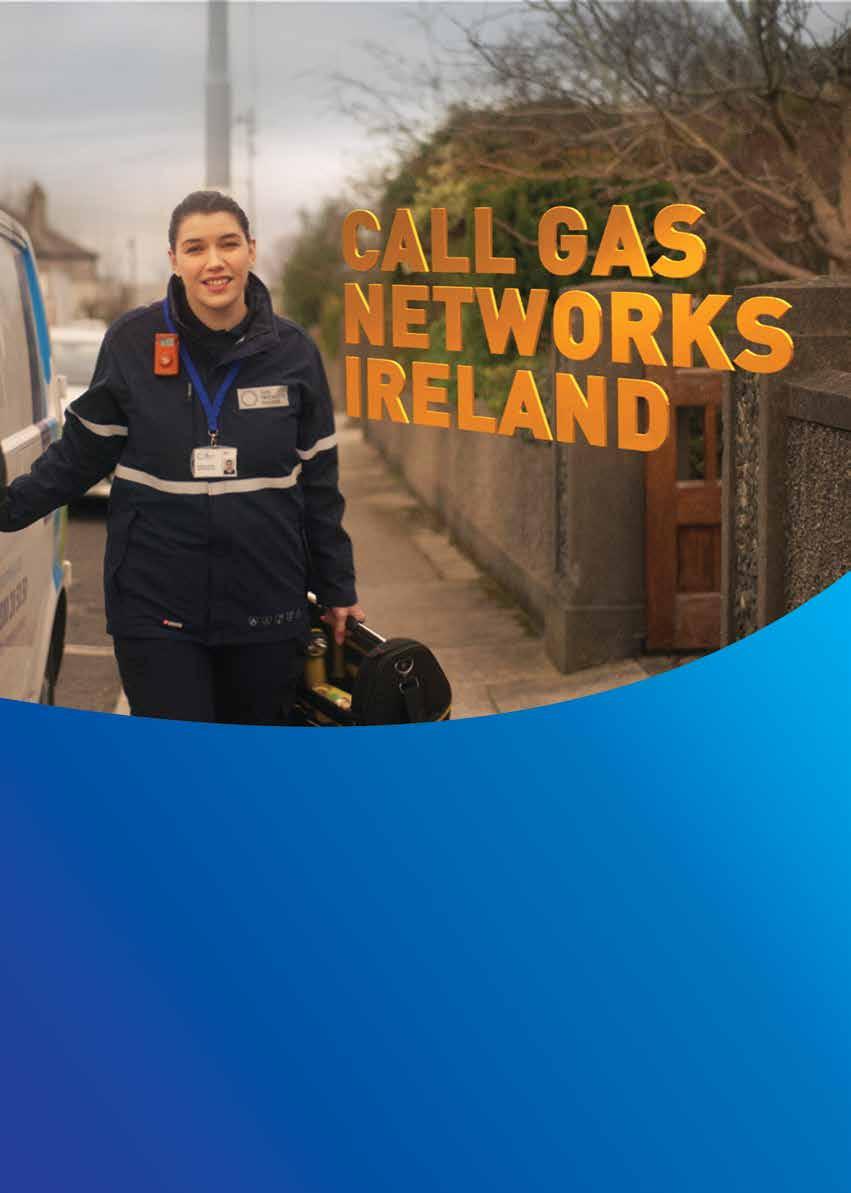
Don’t smoke, vape or use a naked flame
Don’t unplug or switch anything electrical on or off
Turn off the gas at the meter
Then, no matter who your gas supplier is, call our 24 hour emergency service.
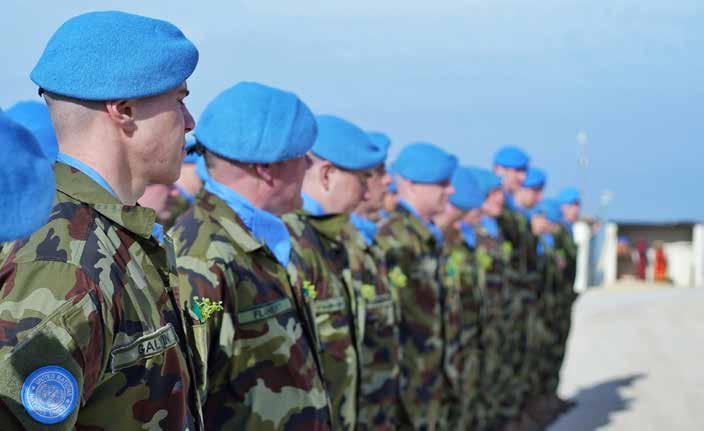
The ‘Triple Lock’ mechanism governs Ireland’s participation in UNIFIL’s peacekeeping mission overseas, which requires UN authorisation, Government approval, and Dáil approval before deployment.
Two certainties arise from this factual statement; firstly, Ireland did NOT comply with its obligations as a supposed neutral during World War 2 from 1939-45 as it provided unqualified support, publicly and secretly, for the Allies; and secondly, the text cited from the White Paper is absolutely in keeping with that of Hague, 1907, for true neutrals.
On 28 April 2003, Mr. Justice Kearns of the High Court, delivered his judgement in a case brought by Edward Horgan against An Taoiseach, the Minister for Foreign Affairs, the Minister for Transport, the Government of Ireland, Ireland, and the Attorney General.
Horgan claimed, inter alia, that “….. permissions granted whereby miliary and civil aircraft of the United States of America are and will be permitted to fly over and through the air space of the State and to land at airports, and in particular, Shannon Airport, Co. Clare within the State and to refuel there and to move troops or convoys of either munitions of war or supplies across the territory of the State constitutes a breach by the State as a neutral State of the customary rules of international
law and is thereby unconstitutional, unlawful, and void by virtue of the Constitution and in particular Article 29.3 of the Constitution.
Mr. Justice Kearns found against Horgan on a myriad of grounds, but pertinently, that Ireland, to date, has not imported Hague 1907 into its domestic law. One asks, was failure to import Hague 1907 into domestic law by design or neglect?
Irish Citizens fed utter falsehoods, particularly since 1939, has led directly to current Triple Lock debate debacle
The widespread attachment of Irish citizens to ‘neutrality’ over the decades is bizarre given that few citizens neither know nor understand the true requirements of neutral states, and obligations arising from that positioning in international affairs.
Neutrality is not established by stating it; actions and reactions are required. Nowhere in international law or practice is neutrality cited, addressed or associated with membership or non-membership of military alliances. In fact, when the Hague Conventions of 1907 were established, no Regional
Independent Senator Gerard Craughwell is a member of the Joint Oireachtas Committee on Defence and National Security. He was first elected in the 2014 Seanad by-election to the Cultural and Education Panel and was subsequently re-elected to the Seanad in 2016 and 2020 to the Labour Panel. Before working in politics, he served in the British Army and the Irish Army. He was also President of the Teachers’ Union of Ireland between 2012 and 2014.


Stafford Bonded is a first class facility for the storage of alcohol products under bond. The storage of wines, beers and spirits under bond is a cost effective business solution. At Stafford Bonded we store your products in our state of the art Revenue approved bonded warehouse s.
Our bonded services include:
- Full load in/out
- Storage in racking
- Order Picking
- Distribution - Drawback
- Monthly and revenue reporting
- Re-packing
- Nationwide delivery service
- International collection
- Customs clearance
- Supply management
- Certificate of Pristine Storage
Stafford Bonded is the market leader in Ireland providing bespoke, all -in-one postdistillery whiskey solutions We manage from bulk to bottle a llowing distilleries to focus on their core business.
Bonded.




Organisations referenced in Chapter 8 of the UN Charter such as the EU, NATO, AU, ASEAN, ECOWAS or IGAD, for instance, were in existence.
The sacred cow of Ireland’s alleged neutrality was created and perpetuated for reasons that, in retrospect, could be construed as opportunistic. Ireland’s stated position of neutrality between 1939-45 is argued as being necessary as to officially side with the Allies would require siding with the UK when a part of the island remained ‘not free’.
‘OCCASIONAL
NEUTRAL STATE’
After World War 2, Ireland’s luck with the victory of the Allies required a continuation of the subterfuge of being as ‘occasional neutral state’, in order to have a fig leaf justification of meagre budget expenditure on its Defence Forces. There was nothing noble in that posture, it was blatant opportunism, couched in preciousness.
Irish. What began as a false expediency became a political trump card to be played out with an agnostic and willingly compliant electorate. It became a welcome vote getter for politicians. That remains true to this day.
However, this longstanding misleading of its citizens is now severely testing the wishes of our government to dispense with the red herring Triple Lock issue. Over the decades it has provided the Neutrality Stick to those who now wish to attach itself permanently to an idealised fantasy called Ireland’s neutrality. Chickens coming home to roost, perhaps!

Ireland, and its citizens, take comfort with what for them is a moral high ground of ‘neutrality’. That subterfuge remains overwhelmingly uncontested as to its accuracy or meaning. Constant recitation of the Falsehoods by government, politicians, commentators, and what passes for our ‘Think Tanks’, have succeeded in perpetuating the neutrality myth.
Outside Ireland, our positioning is tolerated as being merely the eccentricity of the






















A new training programme to improve the quality of cardiopulmonary resuscitation (CPR) was recently introduced by the National Rehabilitation Hospital in Dublin to help clinicians achieve and sustain high-quality CPR skills and competence, ultimately resulting in improved outcomes for patients in cardiac arrest.
The National Rehabilitation Hospital (NRH), located in Dun Laoghaire, is the first one in the country to adopt Resuscitation Quality Improvement (RQI) – a digital CPR training programme with the Irish Heart Foundation.
For decades, the CPR training standard for healthcare providers has been an instructor led Basic Life Support CPR course, with a requirement to renew credentials annually or every two years. However, studies show that skills can decay within three to six months following this training.
The programme will see an estimated 350 health professionals enrol in RQI at the NRH this year and “it will bring game-changing innovation to how we teach and learn critical, lifesaving CPR skills,” according to Geraldine Leete, who oversees Resuscitation Quality Improvement for the Irish Heart Foundation.
“The RQI programme raises the bar in how organisations develop and elevate their healthcare training. Research shows that better quality CPR can have a positive impact on
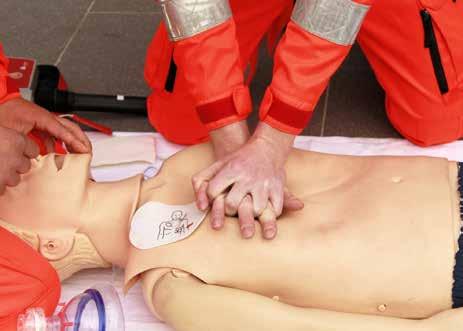
survival. Other public and private hospitals and nursing and medical schools are encouraged to sign up to the programme.”
RQI, co-developed by the American Heart Association and Laerdal Medical, is self-directed, simulation-based training provided through quarterly cognitive and hands-on CPR quality improvement sessions which measure and verify competence.
Courses are delivered through an RQI Simulation Station, which is positioned within the hospital, giving learners greater flexibility and 24/7 access to training. Current face-toface programmes entails releasing staff for periods of 4.5 hours.
RQI is designed to be accessible to all healthcare staff and only requires a shorter period of practice, meaning wards are not short staffed and it ensures staff can maintain their certification.
A study of one such station showed performance in adult/child compressions rose from 84.3% to 96.2% between Q1 and Q5, with adult/child ventilation performance jumping from 79.8% to 95.3%.
Separate US research shows the
percentage of healthcare providers performing excellent CPR more than doubled (from 26% to 65%) when they were retrained three times over six months by using an automated mannequin with real-time feedback.
Attracta Kennedy, Resuscitation Officer at the NRH said: “This is a significant and exciting milestone for the NRH. Delivery of high-quality
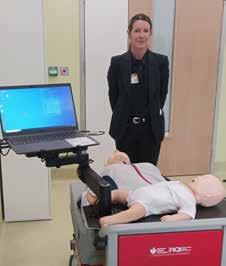
Geraldine Leete, oversees Resuscitation Quality Improvement for the Irish Heart Foundation, says it's a ‘game-changer’ in teaching and learning CPR skills.



CPR training has always been a key priority for the NRH, as is innovation and finding new ways to achieve continuous improvements in our service delivery, and education & training. The move to digital CPR training is another step forward in our digital transformation journey at the NRH.
“We look forward to streamlining and sustaining CPR skills and competence as we transition from instructor led Basic Life Support CPR training to the RQI digital training programme in collaboration with the Irish Heart Foundation.”
“We are excited the National Rehabilitation Hospital is embracing the RQI programme to shift to a new standard of resuscitation care – competence,” noted Gareth Patrickson, RQI Partners’ senior Vice President of International Customer Impact.
“High-quality CPR delivery is a priority, and the hospital joins our commitment to ensuring all healthcare providers in every community are competent and confident in their resuscitation skills to help save more lives from cardiac arrest.
“We celebrate NRH marking a first in Ireland and look forward to nurturing a collaborative relationship rooted in resuscitation excellence.” The RQI programme is marketed, sold and supported in Ireland by the Irish Heart Foundation.




O&S Doors is a one stop solution for all Frontals & Accessories, for the fitted Kitchen, Bedroom and Bathroom Industries.
This year we celebrate 25 years in business and we are proud to announce that we are the UK & Irelands leader in Production, Quality and Service.
We offer the broadest range of Door Styles & Colours across all Frontal Sectors from PVC to Painted, 5 Piece and Cut & Edged. To support this, we have a superb online ordering system available to all Trade Customers with made to measure options.
Our factory in Benburb employs over 360 highly skilled workers, with over 60,000 Door Styles and Finish combinations produced every week.
We offer Ex.Stock and Made to Measure sizes that are all manufactured within the shortest KBB industry lead times.
We continue to invest in Technologies, Automation & Innovations, as well as expanding our chain of Trade Counters which are located in Dublin Santry, Dublin Clondalkin and Manchester.


Links for more information www.irishheart.ie www.heart.org www.laerdal.com www.rqipartners. com
We provide a range of consumer brochures that are designed to inspire you to create magnificent cabinetry. We have brochures for each of our main 4 product ranges: 5G Vinyl, 5Piece, Painted and Edged.

We are a flexible manufacturing partner that will go above and beyond for your business.


Northern Ireland Fire & Rescue Service marked the official opening of its new state-of-the-art Learning & Development College, located outside Cookstown, Co. Tyrone, at the end of May, which was followed by the graduation of its first cohort of full-time firefighters to have completed the 19week intensive training programme at the college in June.

The opening of the new £50 million purpose-built college, which represents the largest investment ever undertaken by Northern Ireland Fire & Rescue Service (NIFRS), was attended by First Minister Michelle O’Neill, Deputy First Minister Emma Little-Pengelly and Health Minister Mike Nesbitt, alongside representatives from NIFRS Board, in addition to local government and community partners.
Supported by the Northern Ireland Executive and the Department of Health, the facility which was completed at the end of 2024, offers immersive training environments and specialist simulation spaces that reflect real-life emergency scenarios.
Phase 1 of the college, which was completed in 2019, includes a tactical firefighting facility and training support building. Phase 2 includes a flood water rescue
facility, a training warehouse, a callout village, a barn and slurry pit, a motorway infrastructure and an academic building.
NIFRS Chief Fire & Rescue Officer Aidan Jennings said the official opening marks a historic milestone for the fire service in Northern Ireland.
“The college is revolutionising how we train and develop our people to meet the evolving needs of a modern-day fire and rescue service and build on the collaborative working with other emergency responders and statutory agencies.
“This is key to successful emergency incident intervention and resolution. The college fosters a culture of lifelong learning and marks the beginning of a new journey that will shape how we prepare, develop and support our people and our community.”
First Minister Michelle O’Neill said


New and Used Mercedes-Benz & Fuso Commercial Vehicle Sales, Service & Parts.


As a Mercedes-Benz authorised dealer, we provide the customer service you expect and associate with this premium product.
The professional, trained personnel in all aspects of our business will provide the correct vehicle or parts to you whilst our service teams will provide the support should you ever require it.
We stock a huge range of makes and models and we are sure that we will have the perfect van for your requirements and budget.
We have a great range of finance providers and can match or beat most finance quotes.
• MINIMUM 6 MONTHS WARRANTY
• FULLY SERVICED
• FULLY VALETED
• CVRT TESTED AND APPROVED

Northern Ireland’s Health Minister Mike Nesbitt, First Minister Michelle O’Neill, Deputy First Minister Emma LittlePengelly pictured with newly qualified firefighters Piaras McCaffery and Caoimhe McNeice, and NIFRS Chief Fire & Rescue Officer Aidan Jenning at the official opening of the NIFRS training college on 28 May.
that the new state-of-the-art facility now provides a world-class training experiences for the fire and rescue service. “And it is no less than our brave firefighters deserve; the people who, day and daily, selflessly confront dangerous situations to keep people safe and save lives.
“As well as being a real asset to the Mid Ulster area, it will stand as a centre of excellence that supports the safety of our whole community for many years to come.”
Deputy First Minister Emma Little-Pengelly said: “This new college will ensure our firefighters can develop the vital skills required to help those in need and to protect our communities in state-of-the-art facilities.”
WORLD-CLASS TRAINING
Health Minister Mike Nesbitt noted that this landmark investment was in the future of the fire and rescue service, in addition to the safety and wellbeing of every community across Northern Ireland.
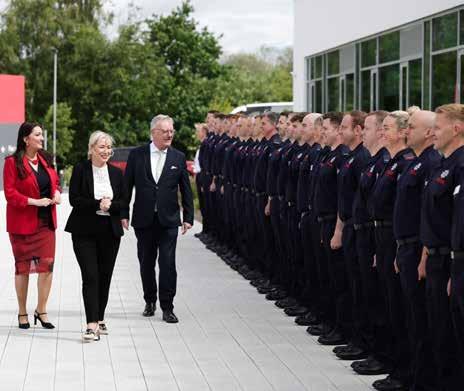
Northern Ireland’s Health Minister Mike Nesbitt, First Minister Michelle O’Neill, Deputy First Minister Emma Little-Pengelly, at the official inspection of the latest cohort of firefighters to graduate at the new training facility.

PBC Biomed Ltd.
4D Western Business Park, Shannon, Co. Clare, Ireland +353 (0)61 704740 info@pbcbiomed.com

www.pbcbiomed.com

150 Peabody Place, Ste. L1007 Memphis, TN 38103 +1 (0)260 750 8110 info@pbcbiomed.com

info@nolancoaches.ie
NIFRS reached a major milestone with the graduation of its first group of full-time firefighters to complete intensive training at the Learning & Development College on 19 June.
The group of 10 female and 31 male graduates will now start their careers as full-time firefighters in fire stations across Northern Ireland.
According to Aidan Jennings, NIFRS Chief Fire & Rescue Officer, “they performed exceptionally well throughout the 19-week duration of the trainee firefighting course”.
He also paid tribute to the dedication and commitment of training instructors, whom he said were also new to the site and who were able to deliver this course to the new recruits.
“Our graduates are now ready to take their places as full-time firefighters across Northern Ireland. They have chosen to become firefighters because they believe in serving our community and working with others to make Northern Ireland a safer place.”
Jay Colville, Chairperson of NIFRS Board, congratulated all trainee firefighters, whom he said were “now equipped and ready to respond and serve the people of Northern Ireland”.






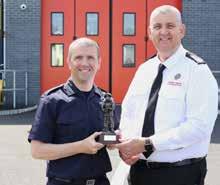




Sportslink was formed in 1993 following the merger of the Public Services Sports and Recreation Complex limited (PSSRC) and the Telecom Eireann Staff Sports Club Limited (Telesport), in association with the Civil Service Football League.

indoor adventure area can facilitate the children while members relax in our cafe, work out, take part in fitness classes or enjoy a peaceful swim.






RTC extrication techniques during a demonstration by the recruits at the official opening.
“It equips our firefighters with world-class training facilities that will ensure they’re trained and ready to face the most complex challenges of modern emergency response.” He commended all those involved in delivering this visionary project and reaffirmed the Department of Health’s commitment to supporting initiatives that protect and save lives.
NIFRS welcomed its first intake of full-time firefighters in February 2025, who graduated in June, following 19 weeks of intensive training at the college.
Since summer 2024. training courses and refresher programmes have been completed at the Cookstown facility, which is now the training centre for all NIFRS fire and rescue staff, as well as other emergency services from across the UK and Ireland, in line with the NIFRS vision – ‘To Become a College of Excellence for Emergency Service Training’.

For background details on the project visit https://www.nifrs.org/home/about-us/learningand-development/
NIFRS Learning & Development College www.youtube.com/watch?v=odNR5aI4iRI
Site Overview www.youtube.com/ watch?v=nwQPbU_kyn I
Many of the buildings and training facilities across the site in Cookstown were completed during Phase 1, with the remaining units finally completed during Phase 2.
• Academic Building
• Breathing Apparatus Charging Facility
• LDC Car Park
• Training Warehouse
• Drill Tower
• Flood Water Facility
• High Volume Pump Training Area
• Call-Out Village
• Urban Search & Rescue Area
• Barn & Slurry Pit
• Tactical Firefighting Facility
• Training Support Building
• Decontamination Zone
• Industrial Training Area
• Motorway & Embankment
• Driver Training Area
• Road Training Network

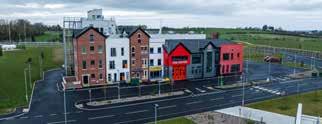


A decision by the National Ambulance Service to freeze the training of new advanced paramedics is delaying patient care and endangering lives, according to those working on the frontlines of emergency medicine, reports Michael McHale.

According to HSE figures, in 2023 an ambulance reached 72 per cent of all life-threatening cardiac or respiratory incidents within 19 minutes of the initial 999 call.
For medical professionals, watching the death of a patient is undeniably difficult. Knowing that more could have been done to save that life can be devastating.
Healthcare workers have shared stories of colleagues on the frontlines of emergency medicine, witnessing patients suffer when the professionals needed to provide critical advanced care were not available to treat them in a timely manner.
In one alleged case, a patient who called ‘999’ with a complaint of chest tightness ended up dying of cardiac arrest. While paramedics had arrived before their death, no advanced paramedic (AP) – the only emergency ambulance staff trained to carry out advanced cardiac life support
(ACLS) – were on the scene to treat the patient in time.
As well as ACLS, APs have the option to give patients any of 23 medications that paramedics are prohibited from administering. These include sedatives and highstrength pain relief. APs – who undergo a two-year MSc degree on top of the three-year undergraduate course completed by all paramedics – may also carry out several life-saving procedures that a paramedic has not been trained to do. These include cardioversion, intubation and intravenous cannulation.
According to HSE figures, in 2023 an ambulance reached 72 per cent of all life-threatening cardiac or respiratory incidents within 19 minutes of the initial 999 call. For other life-threatening callouts, ambulances
reached this time target in 46 per cent of cases that year.
However, without an AP on the scene, the time a patient must wait for a life-saving intervention may be much longer than the time it takes for an ambulance to arrive.
Sources in the National Ambulance Service (NAS) have shared their fears that a shortage of APs actively working on the ground is delaying patient care and endangering lives. They described one alleged incident where a patient whose heart had stopped subsequently experienced CPR-induced consciousness while paramedics were performing chest compressions on them.
In response to the pain that the life-saving CPR was causing, the patient began trying to push the paramedics away – something that, if successful, would have removed all hope of survival. The solution to such a challenge would have been sedation.
However, as paramedics are not trained to sedate patients, an AP would be required. According to one source, paramedics continued chest compressions – all while the patient fought against their life-saving actions – for 30 minutes before an AP arrived.

In several stations across the country, it appears that the percentage of rostered emergency ambulance staff who are APs is as low as 10-15 per cent.
While these events were alleged to have taken place in relatively builtup areas, the problem of AP access is further exacerbated by the difficulties faced in reaching at-need patients in remote rural locations.
“For about half a dozen cardiac arrests over the last few years, I’ve had either no ALS (Advanced Life Support) coming to me whatsoever or have had a delay of 45 minutes to an hour in getting an AP response,”
claimed one rural-based paramedic.
He related cases where patients in severe pain, sometimes living as far as 90 minutes away from their nearest trauma centre, have been left unable to access the high-strength pain relief that only APs can provide in an ambulance setting.
“It’s incredibly frustrating to just watch a patient in front of you suffer when you know that there are interventions that can be done to
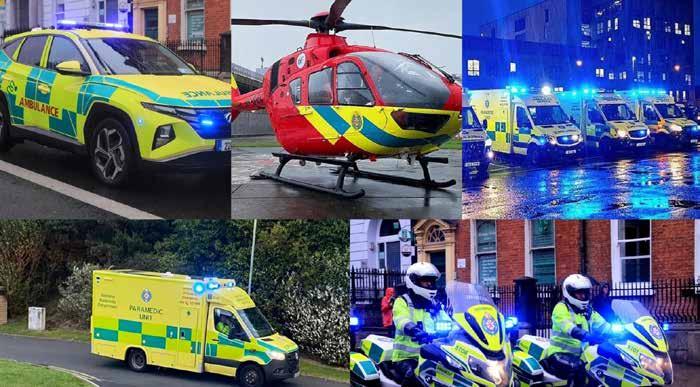
The National Ambulance Service responds to more than 400,000 calls annually, employs around 2,400 staff at 100 locations, and operates 675 emergency vehicles.







Welcometo Tullyhall



TullyhallisanexcitingnewdevelopmentofA-ratedenergy-efficienthomes designedwiththeneedsofthemodernfamilyinmind.
LocatedintheleafysuburbsofWestCountyDublin,Tullyhalloffersurbanliving atitsfinest,whilstgivingyoutheopportunitytosampleandenjoytheenviable facilitiesthatLucanandthesurroundingareashavetooffer.
Thesespacious3bedroomedSemi-Detachedfamilyhomesarefinishedtothe highest of standards,featuringclevertouchestoenhancetoday’sfamilylife. Wherelivingismadeeasy
3BedroomSemiDetachedHome. 1,160sq/ft.
tullyhallhomes.ie
improve their condition, and you just have to sit there and hope that suddenly an advanced paramedic is going to become available.”
The National Ambulance Service responds to more than 400,000 calls annually, employs around 2,400 staff at 100 locations, and operates 675 emergency vehicles. According to an internal audit taken earlier this year, 417 HSE staff currently working with the service are registered as advanced paramedics. The majority were trained to this standard by NAS in programmes accredited by University College Cork.
However, since early 2023 NAS has stopped training new advanced paramedics, and the last internal AP recruitment took place in 2021. The healthcare workers outlined how, since then, they have seen many colleagues with this qualification move into jobs that do not involve emergency ambulance call-out duties, while others who have retired or resigned from the service have not been replaced.

Despite APs operating under clinical guidance from the PreHospital Emergency Care Council (PHECC), the HSE said that there’s no specific AP employment grade. Instead, a new grade of ‘specialist paramedic’ has been created “to address how staff with MSc-level education are employed and deployed to meet patient needs”.
Among this group are Critical Care Paramedics, the majority of whom work in inter-hospital ambulance transfers of patients, and community paramedics, whose aim is to treat, outside of the ED, lower-priority patients who do not need the higher levels of treatment that APs can provide.
“Health services in Ireland continue to see a considerable growth in older patients with more 999 patients needing interventions and clinical decisions which are not within the scope of practice of either paramedics or advanced paramedics,” a HSE spokesperson said.
“In this context, PHECC has developed a Framework for Community Paramedicine in Ireland while NAS has prioritised education capacity on both growing the paramedic workforce to improve access for patients, and the development of community paramedics who have the capacity to treat patients in the community setting and thus avoid an unnecessary ED attendance.”
Several ambulance stations operate work rosters by partnering up
paramedics with APs on shifts. However, due to AP shortages, paramedics are often left without a corresponding AP and are instead partnered with other paramedics.
It appears that there’s a significant number of stations across the country where the percentage of rostered emergency ambulance staff who are APs is as low as 10-15 per cent. Several stations appear to have no APs rostered on any shifts. As a result, APs have often felt the need to respond to emergency incidents when not on duty, particularly if they have access to a rapid response vehicle.
However, a recent instruction by NAS management for staff not to bring work vehicles home outof-hours – in response to a benefitin-kind dispute with the Revenue Commissioners – threatens the continuation of this practice.
In some cases where a family









member is with the patient, paramedics working alone have had to explain to them why the medical interventions they can take to help their loved one are so limited.
“Mostly the general public doesn’t understand what a paramedic and what an advanced paramedic can do, so they’re none the wiser,” one ambulance worker said. “However, anyone who is clued into pre-hospital care knows that there would be other options available to help improve their care.
“Especially with pain relief. If you’ve got a patient in front of you that’s screaming, even with Entonox or Penthrox, but they’re still in large amounts of pain, they themselves know that surely there’s more that can be done here.
“I’m having those difficult conversations where I’m telling the patient that I’m going to make a call on the radio and see if I can get anyone with a higher clinical level than myself to come out and give them something additional.
“Then I have to report back to the patient afterwards and tell them that, unfortunately, there is no one available, so they’re going to be in pain until we get to the hospital.”
In response to a parliamentary question from Sinn Féin TD Máire Devine in February, NAS Director Robert Morton highlighted the AP allowance of just over €11,000 per annum received by staff who are suitably qualified.
“The cost of advanced paramedic education is significant with staff historically receiving an allowance equivalent in excess of 20 per cent additional pay, resulting in considerable competition for course places,” he said.
“The HSE has informed the representative trade unions that there is a need to strengthen the deployment of existing staff with specialist skills to match patient requirements before any consideration can be given to increasing the number of staff with such training.
“The work to do this is encompassed within a broader pay dispute, which is the subject of a WRC (Workplace Relations Commission) facilitated conciliation process, currently underway.”
An agreement between the unions and the NAS on a framework – including a revised pay package – under which paramedics will operate in the future, is expected to be reached. And if not SIPTU will ballot its members for industrial action. (See side panel)
The HSE said the outcome of the WRC talks had been expected to enable a re-calibration of educational priorities, including the commencement of an MSc in Specialist Practice (Community) programme in September 2025 and an MSc in Specialist Practice (Advanced) programme in September 2026.
In his response to Máire Devine in February, Robert Morton referred to an analysis of AP deployment, which he said, “identified that while the number of patient contacts has increased, the level of patient benefit is not commensurate with the level of investment.”
When asked if any patient deaths in the last decade could be attributed to a lack of trained APs, he said that the National Ambulance Service is “unable to speculate on the cause of death of patients who are not in cardiac arrest (clinical death) at the time of a 999 call but subsequently present to the arriving crew in cardiac arrest”.
He added: “The only true correlation between whether an intervention MAY (his emphasis) have prevented death, i.e. a preventable death, is where the coroner makes such a determination. NAS has never received such a determination.”
*This is synopsis of an article originally published in the Irish Medical Times (April 2025).

SIPTU representatives for ambulance workers are due to conclude negotiations at the Workplace Relations Commission (WRC) on a future framework for the National Ambulance Service (at the time of going to press in early July).
The talks, initiated following an independent report that recommended changes to the service, included the examination of revised pay scales for key grades within the ambulance service.
While final proposals have yet to be formally ratified, the deal is set to deliver pay increases for EMTs, Paramedics and Paramedic Specialists (Advanced Paramedics). This development will mark a critical step towards addressing longstanding pay disparities and improving conditions for all frontline ambulance professionals.
SIPTU Ambulance Sector Organiser, John McCamley, said: “The conclusion of these WRC negotiations will bring an end to a prolonged campaign for pay justice for our members in the National Ambulance Service. Despite persistent delays and obstacles from HSE management, we’re finally approaching a resolution that promises to be a positive and constructive outcome for SIPTU members.”
SIPTU Health Divisional Organiser, Kevin Figgis, said: “The proposed agreement follows years of intense campaigning by SIPTU to secure fair pay for ambulance professionals, whose essential frontline role in Ireland’s healthcare system has often been undervalued. Once finalised, the new pay scales will recognise the skills, responsibilities and demanding nature of their work.” SIPTU will provide further updates to members as the process reaches its final stages.











Medicall’s acquisition of Northern Ireland’s ambulance company
Proparamedics earlier this year is set to create the largest private ambulance provider in Ireland by offering an island-wide coverage across 12 bases, with a combined team of 320 medical professionals and support staff and a 70-strong fleet of vehicles, which includes 60 state-of-the-art ambulances.
Founded in 1993 by Paul M. ffrench-O’Carroll, Medicall is the leading provider of specialist ambulance services to public and private sector organisations in Ireland. Both businesses will continue to operate under their respective names and will become part of the newly formed MCL Group, led by Medicall’s Managing Director Jay Gibson.
Derry-born Gibson said that the acquisition of Proparamedics marks a return to his Northern Irish roots. “Over the year Medicall and Proparamedics have worked side by side on several projects, and during this time, it was evident that both companies had many shared values.”
“As we looked to fulfil our ambition of becoming the leading private ambulance provider across the island of Ireland, it was clear that the skills and expertise offered by the wider Proparamedics team were pivotal in achieving this goal,” Gibson noted.
“By combining our considerable resources and breadth of expertise, we can now confidently deliver an unrivalled service to our public and private sector clients, regardless of the size of their requirements.”
Proparamedics, first established in 1999 as Northern Ireland’s first private ambulance service provider by paramedic John Cunningham, has been led for the past 15 years by his sister Heather Hamill-Vaughan, as managing director. She will remain within the business as Director of Service Delivery for Northern Ireland, while Roderick Walsh will continue in the role of Director of Service Delivery for Medicall.
Heather Hamill-Vaughan described it as “a momentous occasion” for the company which has been in family ownership for 25 years. “Since my brother John founded the business with one ambulance in 1999, our team has grown to 130 dedicated healthcare professionals. By joining Medicall, we will be an important part of an exceptional service that prioritises its people and patients across Ireland,” she added.

Hamill-Vaughan, MD of Proparamedics, Jay Gibson, MD of Medicall and Chairman of the MCL Group, Paul M. ffrench-O’Carroll, pictured in Belfast earlier this year, following Medicall’s acquisition of Proparamedics.
“A more blended approach and innovative solutions will be critical as we look to the future. Combining our resources, we will be well-placed to deliver an evergreater level of care and service for patients when they need us most,” according to the Proparamedics MD.
Paul M. ffrench-O’Carroll, Chairman of the MCL Group, said that leading the way in private ambulance services and training has been his focus for Medicall for over 30 years. “Without question we have the resources, expertise and capacity to deliver unparalleled services to patients across the island of Ireland.
“The difference and impact we can make by delivering a seamless service across the country will be hugely beneficial to our health service and private clients. Through our expanded team’s competence, compassion, and expertise, we’ll continue to deliver best-in-class ambulance services and training, and achieve my ambition of offering ‘a career in Medicall.’”
For further information visit www.medicall.ie and www.proparamedics.com
Medicall Ambulance has over 30 years of experience in providing specialist ambulance services to the industry. Founded in 1993 by Paul M. ffrench-O’Carroll, Medicall also offers event medical cover and delivers a range of training services, including internationally accredited emergency medical training.
Proparamedics was established in 1999 as a small family business to provide the highest standard of ambulance and event medical cover through skilled and trained staff. With a team of 130+ staff, services include medical services, clinical personnel and/or transportation, repatriations and first aid training.














An emphasis on alternatives to prison, as outlined in ‘Securing Ireland’s Future: Programme for Government 2025’ and the government’s commitment to enact legislation to extend the use of communitybased sanctions, is encouraging to see, writes the Irish Penal Reform Trust’s Executive Director Saoirse Brady.
The Irish Penal Reform Trust (IPRT) recognises that prison overcrowding is an immense challenge for the government with new records regularly reached across the prison estate. It means that safe capacity levels – as determined by the Irish Prison Service (IPS) – are breached daily.

Saoirse Brady, IPRT Executive Director

The Prison Overcrowding Response Group, comprising officials from the Department of Justice and representatives from the Irish Prison Service (IPS), the Probation Service, the Courts Service and An Garda Síochána, submitted its final report to the Minister for Justice in March 2024.
Significantly, the group reported before record prison numbers reached over 5,000 in June 2024. Since then, this has regularly been exceeded meaning that there are currently more than 500 people in the system without a proper bed.
The Group’s stark warnings stressed the need to take urgent action given the threat posed ‘to the health, safety and wellbeing of prisoners and staff’. Its final report contained several tangible short-term solutions and practical measures that could quickly take the pressure off and provide the IPS with some much-needed breathing space. These include changes to eligibility for temporary release and parole and progressing the Criminal Justice (Community Sanctions) Bill 2014.
We hope that the Group will prioritise this long-awaited legislation and enshrine the principle of imprisonment as a last resort in law. In the past, we have seen the positive impact that progressive legislation can have in significantly reducing the number of people going to prison, for example for non-payment of fines.
The cost of an annual prison space stands at almost €90,000. Prison is expensive not only in terms of the cost to the taxpayer but also in terms of the human cost. IPRT remains concerned at the continued trend of short sentences with a 10 per cent year-onyear increase in 2023 of sentences between threef and six months.
Looking at the pressure on services right across the prison estate, clearly people entering prison for a matter of days, weeks or months will never reach the top of any waiting list to get the necessary therapeutic services to address any underlying issues they might have.
In October 2024, nationally


representative polling conducted by RED C and commissioned by IPRT found that four out of five people supported alternatives to prison for non-violent offenders being prioritised in the Programme for Government. The findings also demonstrate public understanding that many people in prison face issues related to mental health, substance misuse, trauma and lack of access to adequate housing.
More than one in three people favoured personcentred interventions to tackle crime such as additional drug treatment places, extra youth workers, and more consultant psychologists with fewer than one in 10 seeing more prison spaces as a priority.
At a time when other European countries are closing traditionalstyle prisons in favour of smallerscale detention more akin to our open prisons, it is perplexing that this Government appears to favour investment in a new super-prison at Thornton Hall. The commitment to increase the capacity of prisons by 1,500 spaces will not solve today's overcrowding crisis and does little to future-proof the system.
To effectively reduce the prison population, IPRT urges the new Government to shift the focus of Ireland’s penal system away from its current emphasis on punishment towards approaches based on prevention, early intervention, diversion, and the integration of criminal justice policy with wider social policy.
Focusing on measures to support people at risk of criminal justice involvement and addressing the underlying causes of criminality is a much more sensible, humane and effective option.
Along with legislation underpinning and expanding the use of community sanctions, the Government could instead explore small-scale detention options to replace large institutions given it has already demonstrated support for this concept by endorsing the European Council’s conclusions in June 2024. IPRT believes that a whole-of-government strategy to support and promote rehabilitation and reintegration is essential.
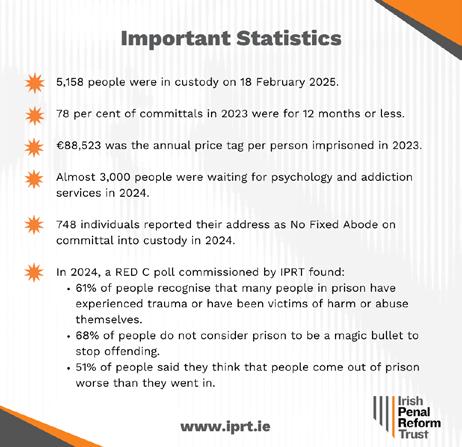
AND PENAL POLICY IN ‘PROGRAMME FOR GOVERNMENT 2025’
Providing adequate prison capacity is essential for ensuring public safety, facilitating rehabilitation, and addressing the needs of individuals within the justice system. Here are key points outlined in ‘Securing Ireland’s Future: Programme for Government 2025’:
• Construct a new prison at Thornton Hall, expand existing prison capacity by 1,500 spaces and consider the need for a new Women’s Open Prison.
• Recruit additional prison officers to support our expanding prison estate.
• Implement electronic tagging for appropriate categories of prisoner.
• Implement electronic warrants and fully digitalise the system of recording sentences and release dates.
• Enact legislation to establish minimum tariffs for any crime that carries a life sentence. • Introduce advanced x-ray body scanners for visitors to our prisons.
• Reform the operation of Prison Visiting Committees.
• Implement an employment strategy for former offenders and support increased access to education and training workshops through the Prison Education Taskforce.
• Establish a high dependency unit in the Irish Prison Service to address severe mental health and addiction challenges and hire more therapeutic and medical staff, including psychiatric nurses.
• Implement recommendations on the Taskforce on Mental Health and Addiction and publish an annual progress report.
• Continue to roll out nationally the voluntary restorative justice programme.
• Enact the Inspection of Places of Detention Bill to enable ratification of the UN Optional Protocol to UN Convention on Torture (OPCAT).




Reforming the Road Safety Authority into two separate agencies is the main recommendation of an independent external review. It will change how road safety activities are implemented, and is part of the second phase of the Government’s current Road Safety Strategy (2021-2030).
Recommendations to reform the Road Safety Authority (RSA) and improve road safety outcomes overall in Ireland were made by an independent external review. This review was commissioned to ensure that the RSA is structured appropriately to fulfil its statutory mandate and help to deliver the Government’s Road Safety Strategy 2021-2030.
It is envisaged that the RSA will be reformed into two independent agencies, one focused on the delivery of services and operations, with the other responsible for wider road safety initiatives including media campaigns, education and research. This reform will be rolled out on a phased and planned basis.
The independent review found that the RSA’s funding model, whereby fees from services (such as Driver Testing, NCTs and Driver Licencing) used to fund the Authority, is unsustainable and in the short term a small increase in fees plus Exchequer funding for public interest road safety activities would be more appropriate.
In the longer term, Government has agreed the recommendation to separate these activities, with the RSA to become an operations-focused agency with a new agency to take ownership of wider public interest activities.
A Departmental Group will be established to consider and progress implementation of the review, while a Road Safety Communications Steering Group will also bring together the RSA communication leads, the department and other key stakeholders to ensure coordination across upcoming campaigns.

The new chair of the Road Safety Authority, Anne Graham, appointed by Transport Minister Darragh O’Brien, in February, takes over from Liz O’Donnell,

whose ten-year term of office expired at the end of October 2024.
A transportation and environment engineer with over 34 years’ experience across the transportation sector, Graham had an extensive career in Dublin City Council, before joining the National Transport Authority (NTA) as a director in 2010. Four years later she was appointed the NTA’s Chief Executive Officer for a ten-year period until December 2024.
Transport Minister Darragh O’Brien said: “Anne has extensive knowledge of the road safety sector and a track record of strong leadership, with great strides made in the provision and update of public transport and active travel in her time in the NTA. As we embark on a process to reform the Road Safety Authority in the coming years.”
Anne Graham said that during her tenure as Chief Executive of the National Transport Authority, significant investment was made in public transport, improved active travel, traffic calming and the public realm, to make Ireland’s roads and built environment safer for road users.
In the past she also worked closely with senior leadership within the Road Safety Authority through the Road Safety Transformation Partnership Board and Ministerial Committee on Road Safety.
“The reform of the Road Safety Authority is an opportunity to ensure that our road safety structures are appropriately set up to deliver the Government’s Road Safety Strategy.” In line with the Road Safety Authority Act 2006, she was appointed as chair on a five-year term (effective from 25 February 2025).
During Liz O’Donnell’s tenure, the RSA continued to deliver on its mission to make Irish roads safer for everyone, which it has performed since the agency was set up in 2006. When O’Donnell was appointed to the role in 2014, there were 163 fatalities.
This figure was reduced to 135 fatalities by 2018, with a further drop to 133 by 2021 (the lowest level since records began in 1959). Notwithstanding the challenges of more recent years, Ireland remains the seventh best performing EU member state for road safety on a per population basis.


Phone: 01 283 2964
Email: info@parkviewortho.ie
Web: parkvieworthodontics.ie
• Early intervention treatment
• Invisalign
• Fixed Braces
• Orthodontics
• X Rays & CBCT Scanner
• Jaw Surgery
Address: 45 Rock Road, Blackrock, Co. Dublin, A94 P8H3 | Unit 3, The Mill Building, The Maltings, Bray, Co. Wicklow, A98 TY26



Staff shortages are having a detrimental impact on patient care, as well as the health and wellbeing of nurses and midwives, according to the INMO. The union’s recent survey revealed that almost three-quarters of nurses and midwives in Ireland claim that their workplaces do not have the right staffing levels and skills mix to meet patient demand.
The findings of the latest survey by the Irish Nurses and Midwives Organisation (INMO), which gathered data from over 2,300 nursing and midwifery staff, were released at its 106th Annual Delegate Conference, held in early May in Wexford.
‘Inclusion Healthcare Starts With Us’ was the theme of this year’s three-day INMO conference, during which delegates debated a range of motions on issues such as staffing, safety and assaults on nurses.
Of those who responded to the survey, 72% said current staffing levels and skill mix in their service did not meet the clinical and patient demands. Among those who cited inadequate staffing in their area of work, over 90% expressed concerns about compromised patient safety while 49% reported feeling pressure


“To
have one in five workers attending their GP for work-related stress…. is the level of sacrifice expected from our members, and it is simply not sustainable” – INMO General Secretary Phil Ní Sheaghdha
to work additional hours or shifts to make up the shortfall.
The effect of this pressure on staff retention was made clear through the INMO survey. Some 61.5% of respondents stated that they had considered leaving their work area over the past few weeks, with the workplace given as the primary reason.
The survey also revealed trends around the impact that work pressures were having on the physical and mental health of both nurses and midwives, with 69% reporting that their work was seriously impacting their physical health, with 55% stating they were “always” or “very often” physically exhausted.
Some 40% also believed their work negatively impacted their
Decotek Automotive design and manufacture premium decorative exterior trim components for the global automotive industry, producing decorative trim for some of the most prestigious car brands in the world.
We have a reputation for world class manufacturing quality in a modern, dynamic and highly automated environment and are looking for dedicated, ambitious and driven individuals to join our high performance team across all Business Functions. Please get in touch if you want to find out more about current opportunities.
www.decotek.com info@decotek.com (044) 966 6600
Mullingar Rd, Collinstown, Co. Westmeath, N91 KHN1

ICS Mortgages has proudly supported Irish public sector employees since 1864. With over 160 years of experience, we understand the unique needs of civil and public servants.
Our new Flexi Interest-Only feature reflects this commitment, by enabling us to assess your income up to three points up the Pay Scale, enhancing your borrowing capacity.
The new feature offers will offer reduced monthly repayments for the first 2 years as it incorporates a 24-month interest-only period at the beginning of the mortgage term, followed by standard capital and interest repayments for the remaining term. While the initial repayments are lower, the overall cost of credit will be higher than a traditional mortgage.
Additional public sector benefits include:
• Enhanced Income Assessment: We factor in up to three points up your pay scale including your latest pay rise if you choose a capital and interest mortgage or up to three points up the PayScale. This forward-looking approach ensures a more accurate reflection of your earning potential.
• Comprehensive Allowance Consideration: We recognize the full extent of your income by including 100% of your allowances and overtime from the previous year.
• Probation Waiver: New public sector entrants and those promoted internally benefit from a waiver of the probationary period. This unique feature streamlines the mortgage process, acknowledging your stable employment status.
ICS Mortgages’ commitment to public sector employees reflects our deep respect and appreciation for the essential services you provide. We understand the importance of stability and security in both your professional and personal lives, and we strive to offer mortgage solutions that support and enhance your journey to homeownership.
Contact ICS Mortgages today on:
0818 427 427 or contact your local Mortgage Broker


Figures obtained by the INMO through a Freedom of Information request have shown that 3,757 nurses and midwives were assaulted in HSE hospitals and workplaces between February 2024 and February 2025. This works out at over 11 people a day who have been verbally, physically or sexually assaulted in work, according to the union.

psychological wellbeing “a great deal” or “a lot”. Of great concern, almost a quarter (24%) of nurses and midwives said they had attended their GP due to work-related stress.
EMOTIONAL EXHAUSTION AND BURNOUT
Almost 70% of respondents saying they often or always felt worn out at the end of the working day, while up to 49% stated they felt exhausted in the morning at the thought of the working day ahead.
The survey also highlighted the level of violence against nurses and midwives. Over half the number of respondents (55%) had experienced aggressive behaviour, while one in five stated they had experienced physical violence at work.
INMO General Secretary Phil Ní Sheaghdha said that their members have been very clear in this survey. “Staffing levels are having a detrimental effect on patient care and a severe impact on nurses’ and midwives’ ability to protect their own health and safety.
“This level of stress, exhaustion and physical strain over many years is having a very serious effect on our members and should not be tolerated. To have one in five workers attending their GP for work-related stress would be a scandal in many workplaces and industries. However, this is the level of sacrifice that is expected from our members, and it is simply not sustainable.”
Ms Ní Sheaghdha said it was “critical” that improvements were made in the coming months to staffing and workforce planning, including legislation around safe staffing levels.
“This needs to happen not simply to protect these healthcare workers and their patients but to protect the future of the health service,” she added.
INMO President Caroline Gourley said that the message from INMO members could not be clearer. “They’re stretched to breaking point trying to keep patients safe in an unsafe working environment, while their own health and wellbeing are suffering as a result,” she added.
She said that it is not realistic or fair to expect people to keep going into work in these conditions, putting their physical and mental health at risk for their work.
“The dedication and commitment of nurses and midwives should not be the glue holding the health service together. Our members’ goodwill is not a substitute for effective workforce planning.”
When it comes to safety at work, one resolution called on the INMO to engage in negotiations for the implementation of the compensatory payment of an allowance for nurses and midwives required to work in unsafe staffing conditions.
Another motion called on the HSE to "introduce appropriate security measures, including an increased security presence along with a clear and supportive reporting system that will encourage nurses/midwives to report all forms of abuse in the workplace".
Figures obtained by the INMO through a Freedom of Information request have shown that 3,757 nurses and midwives were assaulted in HSE hospitals and workplaces between February 2024 and February 2025.
This works out at over 11 people a day who have been verbally, physically or sexually assaulted in work, according to the union.






Local authorities played a vital role in the Government’s response to Storm Éowyn earlier this year, which left chaos in its wake with thousands of people stranded without power many weeks later. In the aftermath of the worst storm to have these shores in recent decades, questions were raised about Ireland’s preparedness for such extreme weather events in the future.
On 24 January 2025, Ireland was hit with one of the harshest storms in 80 years. Storm Éowyn, with record breaking gusts of up to 184kph, caused an estimated €200m in damage, and with red weather warnings issued for 32 counties, the powerful and record-breaking extratropical cyclone wreaked havoc across the country.
Storm Éowyn forced the closure of schools, preschools, universities and many businesses across the country, disrupting transport and causing widespread power outages, which left over one million without electricity across the island and over 200,000 without water. It also claimed the lives of two people in Ireland; a man tragically lost his life in Donegal, when a tree fell on his car, while another died when his medical devices failed.
In the aftermath of the storm, the Government’s response faced severe criticism, particularly regarding the length of time it took for the likes of the ESB and Uisce Eireann to restore power and water, particularly in certain parts of the country.
Around 39,000 people were still without electricity 10 days after the storm, while others were left waiting three weeks or more for ESB crews to fix the issue. Roscommon, Mayo, North Galway and South Leitrim were the areas that suffered the longest power outages, while Galway was worst hit by a lack of water supplies.
The Department of Housing, Local Government and Heritage is the lead government department for storms and severe weather. Its crisis management cell, the National Directorate for Fire and Emergency Management (NDFEM), chaired the National Emergency Co-ordination Group (NECG) for Storm Éowyn.
The National Emergency Co-ordination Group (NECG) was tasked with co-ordinating and concentrating all efforts to restore power, water, telecommunications and other services to homes, farms and businesses in the wake of Storm Éowyn.
“This was done in a virtual capacity, which allowed all departments and agencies plus


Hook Lighthouse is a gem on Ireland’s Ancient East located on the tip of the Hook Peninsula in Wexford, Ireland.
• Open all year
• Enjoy the Cafe and Gift Shop
• Free parking and an extensive picnic area
• Free Wifi
• Relax by the Sea and look out for seals, dolphins and even whales!
051 397 055 / 051 397 054

the local authorities to share crisis information,” Kealan McMoreland, Head of the Office of Emergency Planning (OEP), told ‘Emergency Services Ireland’.
The NECG met two days before the storm made landfall and was briefed by Met Eireann on its severity and the hydro-meteorological situation, which included looking at river, fluvial, surface water and coastal flooding.
“Local authorities activated severe weather assessment teams in advance of Storm Éowyn,” Keith Leonard, National Director of the NDFEM, told ‘Emergency Services Ireland’. “They then mobilised outdoor crews to undertake clearing up operations and co-ordinated assistance from the Defence Forces, Coillte, Civil Defence, National Parks & Wildlife to assist ESB Networks with power restoration efforts.”
The Local Government Management Agency (LGMA) provided two points of contact to the national structure – Meath County Council’s Chief Executive Kieran Kehoe for emergency management, and Carlow County Council’s Chief Executive Coilin O'Reilly for the humanitarian side.
COMMUNITY SUPPORT HUBS
The co-ordination of resources by the

Storm Éowyn was the worst one experienced by ESB Networks in terms of the scale of damage across the network, resulting in 768,000 customers losing supply on the very first day the storm made landfall.
local authorities was “phenomenal,” according to McMoreland, particularly with the establishment of the humanitarian support hubs at local government level.
“Local clubs and groups put their shoulders to the wheel in communities that were massively affected by power outages to establish community hubs off their own bat, which eventually

government and the local authorities could come in and support.”
Hundreds of emergency response hubs were put in place across the country, with the NECG supporting local authorities in these relief efforts, while local co-ordination groups were also put place across countless counties, to direct resources where they were most needed.
For example, groups were in place across local authority areas in Cavan, Clare, Cork County, Donegal, Galway County, Kerry, Laois, Leitrim, Limerick City and County, Longford, Mayo, Meath, Monaghan, Offaly, Roscommon, Sligo, Westmeath, Wexford and Wicklow. “A total 380 emergency response hubs provided basic needs such as water, hot food, phone charging, broadband access, shower facilities, etc,” Leonard explained.
The Humanitarian Assistance Scheme was rolled out for those without power or water supply. It provided non-means tested support payments for essential food, personal items, and alternative accommodation to those living in properties directly affected by Storm Éowyn.
Ireland received several largecapacity generators under the EU Civil Protection Mechanism, from Poland and Denmark, deployed


to support Uisce Éireann and telecommunications operators to bring water, phone and broadband services to homes and businesses. Skilled electrical technicians from Ireland’s counterparts in Austria, Finland and Great Britain were drafted into the worst impacted areas. Further support also arrived from France and the Netherlands. They supported ESB Networks crews and partner contactors, bolstered by colleagues from the south and east of the country, as well as skilled retirees.
However, the Government was accused of not intervening quickly enough; and in particular for not having an effective co-ordinated emergency plan in place to deal with the aftermath of the horrific storm. The Government also came under fire for the delay in restoring power and failing to support businesses and community groups at an Oireachtas debate, some weeks later.
Meanwhile, those left without power had also voiced their frustrations at a lack of communication and the bureaucracy involved in seeking support. It led to calls to improve the Humanitarian Assistance Scheme following reports of people not receiving money, and for the need to expand the scheme
to include businesses and community groups.
“I would like to counter that and say that I had witnessed the engagement between the EU and Ireland, to say that this storm was coming and that we were informing them on how we were being prepared,”
McMoreland said.
He added that the National Directorate had a lot of advanced discussions and knew what the critical events were going to be. “As soon as the damage assessment was done, and we understood the needs, those needs were communicated, and then we got the [EU] generators released”.

Hundreds of emergency response hubs were put in place across the country, with the NECG supporting local authorities in these relief efforts.
Both ESB Networks and Úisce Éireann were heavily criticised for a lack of forward planning, which in Uisce Eireann’s case left key infrastructure without back-up generation capacity. Meanwhile, the ESB was targeted for failing to

improve its response to outages as it has been directed to do so by the energy regulator since 2021, and was also called out for its refusal to make appropriate use of its €898 million profit in 2023 and €706m in 2024.
“As is the case following all severe weather events, and in line with Section 6.15 of the Governmentapproved Strategic Emergency Management Framework, the Department is conducting a detailed review of the response to Storm Éowyn.
“The aim is to identify the key lessons and how learning can be carried forward into future responses,” Leonard said. This review will be submitted to the Government, once it’s approved by the task force on emergency planning.
McMoreland pointed out that it would be “premature” to talk about lessons learned before the completion of an after-action review report. “After a period of almost poly crisis where the systems are activating – standing up and standing down – very frequently, it’s timely to review the Emergency Management National Structures and Framework, based on lessons identified.”
Mount Sackville Nursing Home upholds the 200-year legacy of the Sisters of St. Joseph of Cluny, a congregation renowned for its global dedication to education and the care of the sick, regardless of faith or background.
Originally established over 150 years ago alongside Mount Sackville School, the nursing home began as "the infirmary," caring for elderly and ailing members of the congregation. In 2000, a comprehensive refurbishment transformed it into a modern nursing home registered with the Health Information and Quality Authority (HIQA). Despite these changes, Mount Sackville Nursing Home has preserved its tradition of warm, person-centered, and professional care.
Mount Sackville Nursing Home takes pride in its dedicated multidisciplinary care team, many of whom have years of experience serving this community. Their expertise, continuity, and compassion foster a supportive and trusting environment for residents.
Rooted in a tradition of excellence, Mount Sackville Nursing Home offers a safe, welcoming, and inclusive space for individuals needing long-term care. It continues to embody the principles of service and dignity that have defined the Sisters of St. Joseph of Cluny for generations.
Address:
Contact:




Mount Sackville Nursing Home provides a wide range of facilities and services designed to ensure the comfort and well-being of its residents.
Accommodation & Amenities:
• Spacious and welcoming dining and sitting rooms. A sun lounge for relaxation and leisure.
• On-site oratory and library for spiritual and intellectual enrichment.
• A convenient on-site shop for daily needs.
Comprehensive Care Services:
• 24-hour high-quality nursing care by a dedicated team.
• Long-term residential care for those needing ongoing support.
Health and Wellness Programs:
• Regular hairdressing and chiropody services.
• Access to physiotherapy and Siel Bleu programs promoting physical activity.
• Optician and dental care tailored to residents' needs.
• Engaging activities, both group-based and one-on-one, to promote social interaction and mental stimulation.
Additional Support Services:
• Professional laundry services for residents’ convenience.
• Newspapers provided regularly to stay informed and entertained.
• Pet therapy to enhance emotional well-being.
• Visiting clergy offering spiritual care for residents of all faiths.










Digital twin technology to improve real-time decision-making in emergency situations is undergoing a series of trials on the campus of Dublin City University, as part of the Digital Twins for Emergency Management project. The pilot scheme is testing the technology before deployment across the wider area of Dublin City, and subsequently on a national scale.
DCU Business School, DCU Insight and Dublin Fire Brigade (DFB) are pioneering the next generation of smart emergency management solutions. By harnessing their combined expertise, these partners are spearheading groundbreaking innovations in digital twin technology, setting a new benchmark for risk assessment, pre-incident planning, and emergency management.
The Digital Twins for Emergency Management (DT4EM) project is revolutionising traditional emergency management practices, particularly in terms of pre-incident planning with Dublin Fire Brigade (DFB). Historically, these procedures have relied on paper-based methods, requiring extensive time and effort to create and retrieve critical information during emergencies.
The DT4EM project now aims to fully digitise this process, drastically reducing the time needed for preincident planning. With this new framework, all essential data will be accessible on a digital device, significantly enhancing the speed and efficiency of emergency response.
This collaboration between DCU Business School, DCU Insight and DFB is now poised to transform
The DCU campuses are the testbed for trialling and refining the application of digital twin technology before wider implementation across the Dublin City region.

emergency management, enhancing real-time decision-making and operational efficiency through cutting-edge digital solutions.
A key objective of the DT4EM project is to improve real-time decisionmaking during emergencies. By creating a dynamic 3D model of emergency sites, digital twin technology integrates live data from multiple sources, providing emergency responders with instant access to crucial information such as building layouts, hazard locations, and resource availability.
This enhanced situational awareness allows for optimised resource deployment, helping first responders and campus managers make quicker, more informed decisions in critical situations.
The DT4EM project is driven by a multidisciplinary collaboration between DCU’s Insight Centre, Smart DCU, Bentley Systems, DCU Business School and DFB. By combining academic research with emergency management expertise, this partnership fosters innovation
and ensures the technology is both practical and impactful.
DCU’s campuses are serving as the testbed for trialling and refining these digital twin applications. The campus infrastructure offers a controlled yet complex environment for realistic emergency scenario testing to ensure the technology is rigorously validated before it is deployed across the Dublin City area, and subsequently across the country.
At an event at DCU Business School earlier this year, members of the Emergency Management Institute Ireland (EMII) and leading experts in emergency management came together to explore the transformative potential of digital twin technology.
Organised by Prof Caroline McMullan and researcher Romal Thakkar, the breakfast briefing event in February showcased the project’s innovative strategies for enhancing risk and emergency management.
Experts from DCU’s Insight Centre, DCU Business School, and Dublin Fire Brigade delivered insightful presentations on the practical applications of digital twin technology in emergency management.
Dr Ali Intizar, Co-Principal












Pat Leahy, former Garda Assistant Commissioner, joined the discussions on digital twin applications for emergencies, before he explored its potential using VR technology at DCU Business School.
Investigator of the DT4EM project at DCU School of Electronic Engineering, alongside Dr Jaime Fernandez from Insight Centre, together with DFB’s Michael O’Donnell and Robert Howell, shared groundbreaking insights into the future of pre-incident planning and emergency management strategies.
"Over recent years, we’ve successfully created a digital twin of DCU campuses, enhanced with real-time data analytics. This has served to highlight the transformative power of digital technologies for smart city applications, significantly improving our quality of life and society,” noted Dr Intizar.
“The DT4EM project exemplifies the crucial realworld impact of digital twin technologies, particularly in emergency response and risk management, where their benefits are most critical,” he explained.
The successful adoption of digital twin technology will pave the way for a safer, more responsive future, enhancing emergency management both on campus and across the city.
“The DT4EM project, spearheaded by Insight/DCU and Dublin Fire Brigade, holds the potential to redefine the emergency services sector by integrating advanced academic and sector-specific expertise.
“By leveraging real-time data, the project empowers emergency responders to act with greater precision, reducing response times and ultimately safeguarding lives in critical situations," noted Celine Heffernan, Business Development Manager at the Insight Centre.
"Digital twin technology represents a transformative leap forward in emergency management, allowing us to simulate and visualise real-world scenarios in real-time. By bridging the gap between digital innovation and practical emergency response, we can ensure faster, more informed decisions that save lives and protect communities," Romal Thakkar, DT4EM Project Researcher, pointed out.
Prof Caroline McMullan, Co-Principal Investigator of the DT4EM project, said it has been “incredibly exciting to collaborate with leading experts in data analytics, digital technology, emergency management, in addition to the fire and rescue service to create a best-in-class approach to pre-incident planning and broader emergency management”.
Prof McMullan noted that this partnership not only enhances risk and emergency management capabilities on the university campus in the short term “but also lays the foundation for a transformational shift in this field over the medium and longer term”.
Dennis Keeley, Chief Fire Officer, Dublin Fire Brigade, told the EMII breakfast meeting that having worked on a range of technology projects during his career, he has concluded that “assisting emergency response technology is only as good as its usability and clear added value; if it is not simple, intuitive and does not solve problems immediately, then firefighters are less likely to adopt any of these initiatives”.
With the DT4EM project being developed with practitioners and academics from DFB and DCU/Insight Centre, DFB’s fire chief said that every aspect of the project is being developed with user experience and safety benefits in mind.
“It is anticipated that the integration of this project, upon completion, will help streamline everything from pre-planning and training to emergency response to post-incident analysis,” he noted.

Dr Ali Intizar, Co-Principal Investigator of the DT4EM project at DCU School of Electronic Engineering, shared some insights into the future of pre-incident planning and emergency management strategies, using digital twin technology.

FUNERAL
William: 087 205 3129
Mark: 086 988 1771
William: (087) 205 3129
Mark: (086) 988 1771
E: info@williamryanandsons.com www.williamryanandsons.com
Email: info@williamryanandsons.com

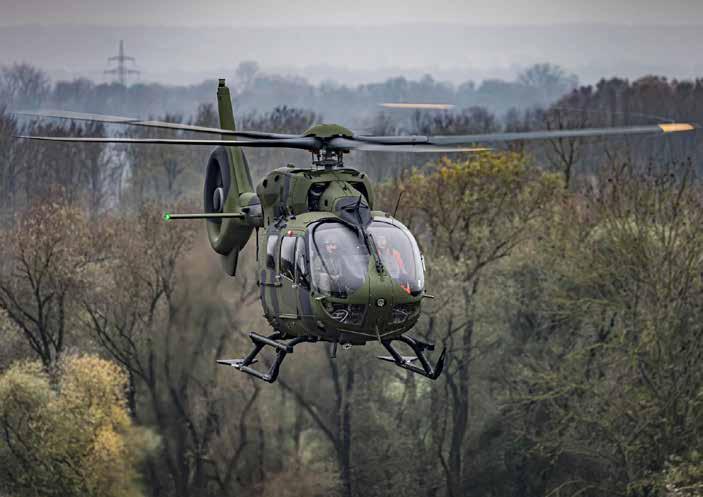
The Department of Defence has signed the contract for four new Airbus H145M helicopters for pilot training to support Defence Forces operations and the Garda Air Support Unit. The €91.7m contract has been awarded to Airbus Helicopters UK Ltd and it is anticipated that delivery will be rolled out in the first quarter of 2027.
The new fleet of helicopters aims to significantly boost the capacity of the Defence Forces pilot training programmes and enhance intelligence, surveillance, reconnaissance and light combat capabilities of the Irish Air Corps.
Speaking at the signing of the contract on 30 December 2024, Micheál Martin, the then Tánaiste and Minister for Defence said that the investment is further evidence of the Government’s commitment to enhancing our Air Corps.
“This is illustrated by the delivery of two C295 maritime patrol aircraft over the last 18 months, and the expected delivery of a C295 military transport aircraft in 2025. These significant additions to the Air Corps’ capability will be complemented by the acquisition of the new Falcon 6X multi-purpose strategic reach aircraft,” he added.
The Airbus H145Ms represent a vast modernisation and expansion of light-utility helicopter capability for the Air Corps over the present ageing EC-135s, which the government said have reached the end of their useful service life.
In July 2024 in response to a question by Labour’s Deputy Alan Kelly, Micheál Martin said about the Garda Air Support Unit EC135s, one of which is older than the Air Corps EC135: “At present there is no target date for the disposal of these aircraft nor is there any mechanical end of life date for operating these airframes.” In November 2021,








Maldron Hotel Portlaoise, Abbeyleix Road, Meelick, Portlaoise Co. Laois, R32 HKN3.












Airbus H145-M helicopters represent a vast modernisation and expansion of light-utility helicopter capability for the Air Corps over the present ageing EC-135s, which the government said have reached the end of their useful service life.
‘272’ passed the 10,000-hour milestone. The Air Corps EC135’s. ‘270’ and ‘271’, were both delivered to Casement Aerodrome on the evening of 3rd November 2005.
The multi-role capability of the new H145Ms means that they will be equipped to satisfy a wide range of missions including maritime security missions, utility missions, Intelligence, Surveillance, Target Acquisition and Reconnaissance (ISTAR) and light attack missions. As well as enhancing the Defence Force’s current ISTAR capabilities, there will be enhanced electro-optical and thermal imagery features not available in the current rotary wing fleet.
The overall aim is to greatly improve the operational support provided to Special Operations Forces – the Army Ranger Wing – as well as providing broader

support across the Defence Forces training and operations. The contract for the new helicopters has been awarded to Airbus Helicopters UK Ltd. The value of the contract is €91.7 million, and it is anticipated that delivery will begin in the first quarter of 2027.
Defence Forces’ Chief of Staff, Lieutenant General Seán Clancy, added: “The procurement of the Airbus H145M helicopter platform is another important step on the journey of transformative change of our Defence Forces. These new light multi-role helicopters, proven in their service in other militaries, will not only enhance the Irish Air Corps rotary capability but will also serve as a critical enabler to the Army, Naval Service and Special Operations Forces.”

Brigadier General Rory O’Connor, General Officer Commanding (GOC) of the Irish Air Corps, said: “The acquisition of these light multi-role helicopters marks a significant milestone for the Air Corps, which will serve as a critical enabler for training, ISTAR and armed support operations.
“The helicopters will provide vital light tactical transport support to the Army, Navy, and Army Ranger Wing, reinforcing our interoperability with Special Operations Forces. They will also play an important role in shaping the next generation of rotary-wing pilots, ensuring the Irish Air Corps remains agile, adaptable, and mission-ready for years to come.”
Last year the Department of Defence awarded a contract for the preparation of a detailed airside infrastructure masterplan for the development of Casement Aerodrome, which will identify the requirements for airside infrastructure over the next 20 years. Budget 2025 has provided an additional €8 million to support Air Corps fleet maintenance, airfield and training costs.










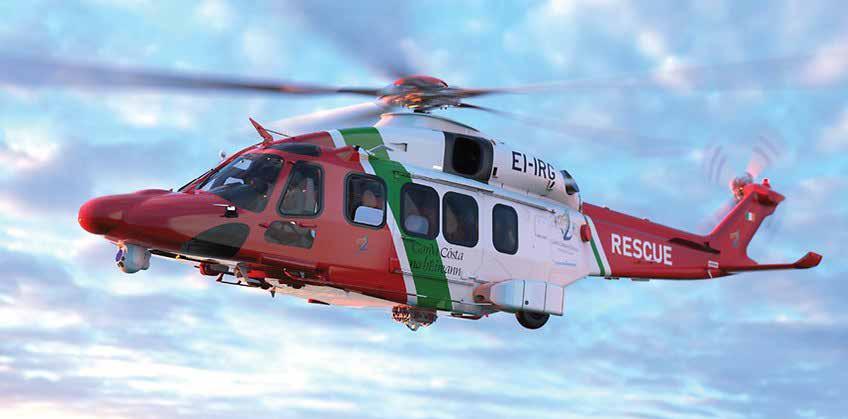
Last year was another busy and eventful one for the Irish Coast Guard.
Throughout the year, it co-ordinated a total of 2,554 incidents which included search and rescue, maritime casualty responses and pollution and preparedness responses.
The Irish Coast Guard mobilised 44 units on 1,154 occasions last year, as it continued to support communities across the country by providing 134 air ambulance flights in support of the offshore island communities.
The Coast Guard provided critical assistance to 537 people during 2024, preventing loss of life and/ or delivering people to appropriate medical care. It also collaborated with the wider search and rescue community throughout the year, with the three Irish Coast Guard Maritime Co-ordination Centres in Dublin, Malin and Valentia tasking RNLI lifeboats on 699 occasions, and launching the community in-shore rescue service on 73 occasions.
In December 2024, the first two of the new Leonardo AW189 helicopters, provided by Bristow Ireland Limited under the new aviation service contract, commenced operation in Shannon. The other four helicopters are scheduled for delivery early this year.
PHASED TRANSITION OF FLEET
Releasing the response figures for 2024, the Irish Coast Guard said: “The priority of the phased transition to the new contract was ensuring the safety of the helicopter





crews, Irish Coast Guard members and other stakeholders who will be working alongside the helicopters.
“This important milestone was achieved through positive collaboration between the two contractors and the Department of Transport and support from the wider search and rescue community.
“The other three SAR (Search and Rescue) bases in Dublin, Sligo and Waterford are continuing the transition to the new contract and will commence operation in the first half of this year. The Coast Guard also looks forward to welcoming the first fixed-wing aircraft to the IRCG fleet over the coming weeks.”
Joanna Cullen, Assistant Secretary General at the Department of Transport with responsibility for the Irish Coast Guard, thanked all Coast Guard members whom she said have shown, once again, their dedication to keeping the Irish coastline safe.
She also extended her appreciation to the staff based at the three Maritime Rescue Co-ordination Centres, “who remain vigilant both day and night and ensure our critical work continues”.
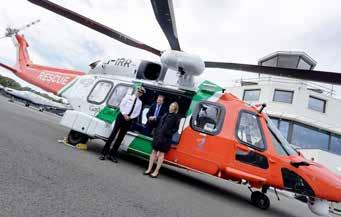
Dept of Transport’s Assistant Secretary General Joanna Cullen pictured with Coast Guard Director Micheal O’Toole and James Lawless, Minister of State at the Dept of Transport with responsibility for the Coast Guard, as the first new AW189 helicopter landed at Weston Airport in August 2024 (one in a fleet of six under the new tenyear contract with Bristow Ireland).

Members of the new Irish Coast Guard’s helicopters operational aircrew and engineers pictured at Shannon Airport as the service commenced operations from the airport on 8 December 2024. (Pic: Bristow Group)



COAST GUARD’S YEAR IN FIGURES
• The 44 Coast Guard Units were mobilised on 1,154 separate occasions.
• Coast Guard Helicopters conducted 752 missions.
• Critical assistance was provided to 537 individuals (preventing loss of life, and/or delivery to appropriate medical care).
• Coast Guard helicopters conducted 134 air ambulance flights in support of the offshore island communities.
• RNLI responded to 699 incidents.
• Community in-shore rescue service was launched for 73 taskings in 2024.


Lovin Catering is family business. It was established by Kevin & Natasha in 2010 and has been trading for the last fourteen years, supplying Catering for Corprate and Home Events in Dublin & Surounding areas.
We also provide a Professional Catering Service for Corporate Lunches, Outdoor Events, Servicing Offices big & Small across Dublin, offering a verity of catering packages that suit any event.
We cater for all occasions, Birthday Parties, Anniversaries, Christenings, Communions, Confirmations, Funerals, Canapé receptions, lunches, and lots more.
You can browse our Full Menu at www.lovincatering.com or Contact Natasha on 01-4544912.

The key to your security
Fast, Reliable & professional Service with over 50 Years experience Ryan’s Locksmiths provide locksmith solutions for homes and businesses in Limerick and the surrounding area. We also provide auto locksmith services for car lockout emergencies.
Our Services Include:
• Access Control Systems
• Car keys cut to car locks
• Transponder Car Keys Cut
• Car Keys programmed on site- No towing involved
• Commercial & Domestic Safes supplied & fitted
• Yale type locks fitted to Munster Joinery Doors
• Commercial and Automotive
• Locks keyed alike
• Security Advisory consultants
Call 061 414173 www.ryanslocksmiths.com E:sales@ryanslocksmiths.com
7 Upper William Street, Limerick V94 AD80

The Glenroyal Hotel and Leisure club is located in the

Maynooth, Co Kildare
Email: info@glenroyal.ie
Tel: +353(0)16290909 Web: www.glenroyal.ie
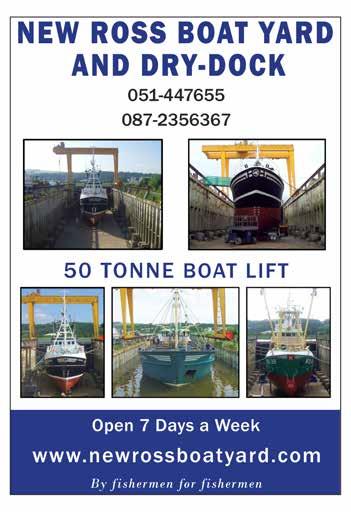
Three sisters from Tralee won the top prize at this year’s BT Young Scientist of the Year for their smartphone technology project – ACT (Aid Care Treat): App-timising emergency response – which they developed over the last 12 months to greatly improve the response of the health services in emergency situations.
Ciara (17), Saoirse (15) and Laoise Murphy (12), who are in 5th, 3rd and 1st year respectively at Presentation Secondary School Tralee in Kerry, won the overall award at the 61st BT Young Scientist & Technology Exhibition (BTYSTE) for their innovative technology project.
ACT (Aid Care Treat) – a medical assistance app designed to support emergency healthcare responses –integrates crucial features to provide swift and effective aid during critical situations. This is the second year this project has been recognised at the exhibition having previously been awarded the Runner-Up Group in 2024.
The transformative app is designed to tackle challenges in transferring medical data effectively and efficiently to the emergency services. It also has the capability to share precise geolocation coordinates. Once the data reaches the emergency services, there is the possibility for onward transmission to the dispatch control centres, the attending mobile units and the hospitals in a matter of seconds.
The Tralee sisters spent the last 12 months working on their project along with the Department of Health, the HSE and the National Ambulance Service, together with An Garda Síóchána, to maximise the potential of their app.
Following the presentation of the award, Ciara Murphy said that it was “absolutely unbelievable” adding “we’re so, so honoured and delighted that we have been selected by the judges. It has been the most phenomenal experience, and this has been the most perfect way to end it, and we’re very thankful to everyone”.
Their father Seamus Murphy said that his daughters received great support from all the stakeholders
involved in the project, adding that “it’s been a really worthwhile and rewarding experience”.
With the app’s potential to have real-world applications, their mother Theresa pointed out the project initially started out following “an incident that happened within the family, and the panic that ensued as a result of a medical emergency. They immediately started to think how do teenagers and young people with a situation like this.”
Congratulating Ciara, Saoirse and Laoise on bringing this project so far, Prof Joe Barry, Chair of the Health & Wellbeing Group Judging Panel, said that their smartphone technology has the potential to save lives and reduce recovery times. “With the support of the emergency services, this project has the potential to make a real difference in helping citizens in an emergency situation.”
A former teacher at Presentation Secondary School in Tralee, Norma
Foley, then Minister for Education, congratulated the sisters on their extraordinary achievement of winning top prize in the BT Young Scientist & Technology Exhibition 2025.
“This win is testament to their creativity, dedication and hard work and the tremendous support of their family, teachers and school. Back in 1963, the founders of the competition – Dr Tony Scott and Fr Tom Burke –presented a vision and today in 2025, we congratulate the winners of the 61st Young Scientist competition – an outstanding legacy.”
She also thanked BT for their continued dedication to supporting and empowering students through this exhibition. “The most outstanding aspect is the absolute engagement of students and their enthusiasm. It has been a privilege to meet them here in the RDS and to see the innovation, creativity and attention to detail in their projects.”
Minister Foley said that it was heartening to see that Irish postprimary students in second year were in top position in the EU in

January.







mathematics and science in the latest international assessment of mathematics and science achievement – known as TIMSS 2023. “The BT Young Scientist & Technology Exhibition plays a key role in promoting our young people’s interest in Science, Technology, Engineering and Mathematics (STEM).”
In addition to receiving the top prize of €7,500, the Tralee sisters will now represent Ireland at the European Union Contest for Young Scientists (EUCYS) in Riga, Latvia in September. And this year for the first time, as the overall BTYSTE winners, together with the Best Individual winner, they will be awarded a trip to the World Expo, in Osaka, Japan.
Tomás Markey (18), a sixth-year student in St Brogan’s College, Bandon in Cork, won the Best Individual prize with his project, PMDAC: A system for removing CO2 from the atmosphere. PM-DAC is a Passive & Modular Direct Air Capture framework that reduces the cost of carbon dioxide sequestration in the fight against climate change.
Leonard Hobbs, Chair of Technology Individual Judges, said, “The judges were very impressed with the level of innovation demonstrated by Tomás Markey who addressed one of the greatest challenges currently facing the world in the excess of carbon dioxide in the atmosphere.
“Tomás demonstrated his prototype at the exhibition which showcased an impressive mechanical and scalable design and novel

carbon capture technology, which resulted in a cost-effective approach to this challenging and topical issue.”
Shay Walsh, Managing Director of BT Ireland, congratulated all the participants and finalists of this year’s BT Young Scientist & Technology Exhibition, whom he said have not only showcased some truly innovative project ideas, but have also done themselves, their teachers and schools, and families proud.
“In addition to demonstrating boundless energy and ingenuity across topics ranging from Artificial Intelligence (AI), cyber security, mental health, sustainability, agriculture and many more, what has been most

uplifting is seeing how STEM subjects can be used for the betterment of society and the world around us.
“Over the last 25 years, since taking up the custodianship of the YSTE, BT Ireland has been honoured to play our part in evolving one of the most prevalent and longstanding STEM exhibitions in the world. We look forward to seeing what exciting endeavours our winners have in store in the months and years ahead.”
This year’s video highlights can be seen on the BT Young Scientist YouTube Channel youtube.com/@ BTYoungScientists
BT Young Scientist & Technology Exhibition (BTYSTE): The annual exhibition is designed to raise schools’ engagement in the critical subjects of Science, Technology, Engineering and Maths (STEM). Each year, students aged 12 to 19 years from all over Ireland are invited by BT to showcase their science and technology projects. For more information visit www.btyoungscientist.com
World Expo: Held every five years, Expo 2025 will once again bring the world together to explore the future of industry, technology, and progress. Inspired by Ireland’s theme ‘Creativity Connects People,’ the winners will have the opportunity to create meaningful intercultural connections, experience cutting-edge science, and showcase their research on a global stage. For more information on Expo 2025 visit www.expo2025.or.jp/en/




150 year old, family-owned city centre pub located around the corner from Pearse St. Garda Station.
Perfect for watching the latest Live Sports or just a casual meet up with friends.
Lunch Service is available from 12pm - 4pm every day.
Dinner Service is available from 4pm - 10pm every day.
We also cater for Private Parties downstairs in the Station Bar and we also cater for large Group Bookings with our 3 types of Sharing Platters (Vegetarian, Kennedys & Luxury).
The Cloud Device
Call Or Email Us For More Details



The LL Brand uses a graphic cloud device to build a unique and recognisable style across all applications. The device can be used to house an image, heading or to isolate the logo. For examples of the cloud device in use, see The Brand in Action Section page 10.




File identifier:
sky_Graphic.eps
Editable file for use in all applications
Help us make the most of short and precious lives
LauraLynn is Ireland’s ONLY children’s hospice. We provide palliative care and support to children with life-limiting conditions and their families.
sky_Graphic.jpg
For use in inhouse presentations
Choose LauraLynn as your charity partner:

The Rainbow
The rainbow support graphic should only be used when there is a large graphic area and it doesn’t interfere with or distract from the brand identity.



OxygenCare, a leading provider of medical equipment and solutions in Ireland, has signed a new partnership with Defibtech, the US manufacturer of resuscitation devices, to improve the availability of rescue-ready defibrillators in Ireland in a bid to save more lives.
The recent report from the European Court of Auditors points out that EU money to tackle forest fires is not systematically spent where needs and risks are highest, or with a long-term perspective, although it is crucial for getting tangible results.
While the precise amount of EU money spent on tackling forest fires is largely unknown, the report notes that more and more EU funding (through the Recovery and Resilience Facility) could be used for that purpose. And because prevention is better than cure, EU countries now tend to focus more on preventive measures, such as creating firebreaks and clearing vegetation.
In Portugal, for instance, the EU auditors noticed that the percentage spent on prevention rose from 20% to 61% between 2017 and 2022. Similarly, in Spain’s north-western Galicia region, prevention has made up the lion’s share of the forest-fire budget since 2018.
Nevertheless, forest fires have intensified in recent years, in terms of both quantity and scale. The number of forest fires affecting more than 30 hectares tripled in the EU between 2006-2010 and 2021-2024, reaching an annual average of almost 1,900 in the latter period.
Consequently, the affected area has also significantly increased, to a yearly average of more than 5,250 km2 in the last four years. In other words, the equivalent of twice the area of Luxembourg goes up in smoke in the EU each year.
“Strengthening preventive measures against forest fires is certainly a move in the right direction,” noted Nikolaos Milionis, the ECA Member responsible for the audit. “However, to prevent EU

support from being just a flash in the pan, EU money must be spent in a way that ensures best results and a sustainable impact.”
The auditors believe that the projects selected to receive EU funds do not always target areas where the impact will be greatest. In some Spanish regions for example, the budget was shared between all provinces, regardless of risks and needs. In addition, the auditors found some of the measures that were financed were based on outdated information.
In Greece, where the burnt area in 2023 was more than three times the annual average for 2006-2022, the list of areas prone to forest fires is more than 45 years old. In Portugal, the auditors discovered that a partly flooded area was prioritised to receive EU money to tackle forest fires. The reason was that the hazard map was not up to date, ignoring the
fact that a dam had been built there several years ago.
All in all, the auditors conclude that it is difficult to know the actual results achieved by EU funding to tackle forest fires in Europe. But this is not only due to a lack of data, inconsistent indicators, or poor monitoring: it is also because the sustainability of financed actions is not always ensured, particularly where the RRF is concerned.
Although the RRF has provided significant additional one-off funding (e.g. €470m in Greece for preventive works and €390m in Portugal), no EU or national money is secured in these countries to ensure that preventive measures remain effective in the long run. The European Court of Auditors, therefore, conclude that the impact of EU action on prevention could be limited to a maximum of three or four years.
European Court of Auditors – the external auditor of the EU – check if EU policies and programmes provide value for money, and if the collection of contributions to and spending from the EU budget is legal and regular. For further information visit www.eca.europa.eu/en
Mobile phones across the UK will sound a loud, 10-second alert on Sunday 7 september at 3pm, as part of the government’s latest emergency alerts system test.
The system, designed to warn the public of lifethreatening dangers like extreme weather, sends urgent advice directly to phones – even when devices are on silent. This will be only the second national test, affecting around 87 million phones. A message will confirm the alert is a test.
The trial is part of wider efforts to strengthen the UK’s emergency response capabilities. Since the system’s launch in 2023, five alerts have been issued, including during Storm Éowyn in January 2025, when 4.5 million people in Scotland and Northern Ireland were warned of a red-level threat to life.
Other activations included a WWII bomb in Plymouth, flash floods in Cumbria and Leicestershire and Storm Darragh in December 2024, which killed two people after triggering alerts to 3.5 million people in Wales and the South West.
To raise awareness, a public information campaign will run in advance of the test, with targeted communications for vulnerable groups, such as victims of domestic abuse and British Sign Language materials.
The announcement comes as Chancellor of the Duchy of Lancaster, Pat McFadden, unveils a new Resilience Action
Plan, part of the government’s broader Plan for Change strategy. The government has also pledged £1.3bn to establish a network of National Biosecurity Centres and £4.2bn through DEFRA to develop a new generation of flood defences. (Source: EmergencyServicesTimes.com)

Hundreds of paedophiles, rapists and violent robbers have been arrested by officers in the Metropolitan Police using Live Facial Recognition (LFR) technology, the force has announced.
Among the more than 1,000 arrests are at least 100 individuals allegedly involved in serious violence against women and girls (VAWG) offences such as strangulation, stalking, domestic abuse and rape. The Met says it’s taking the lead in using this technology, using it to identify and apprehend offenders who pose a significant risk.
So far, of the arrests made using LFR, charges or cautions have been given to 773 perpetrators. LFR is also used to locate those who are breaking bail conditions without the need for extensive police resources or frequent visits.

Lindsey Chiswick, lead for LFR at the Met and nationally, said: “This milestone of 1,000 arrests is a demonstration of how cutting-edge technology can make London safer by removing dangerous offenders from our streets.
“LFR is helping us deliver justice for victims, including those who have been subjected to horrendous offences, such as rape and serious assault. It is not only saving our officers’ valuable time but delivering faster, more accurate results to catch criminals – helping us be more efficient than ever before.”
The Met said that each deployment is made up of an LFR team as well as several neighbourhood officers in the vicinity to talk to those identified and make necessary arrests.
LFR interventions do not always result in arrest, and the tool is often used to stop people who are flagged from the watchlist who have conditions imposed by the courts.
These may include registered sex offenders and those convicted of stalking, among others. The interventions are crucial as they are another way of police ensuring that people are adhering to their conditions. In turn, communities are kept safer as a result.
In London, a breach of conditions has been identified 21 per cent of the time. The Met also noted that, in total, 93 registered sex offenders have been arrested by Met officers as part of the 1,035 arrests seen since LFR technology was introduced at the start of 2024.
Emergency Services Day, also known as ‘999 Day’ which takes place on 9 September each year, will once again honour and recognise all EMS personnel in the UK who work and volunteer across the NHS, police, fire, ambulance, and search and rescue services.
‘999 Day’ not only serves as a platform to enable the country to show its support for those who serve but also aims to increase public understanding of how to use the emergency services efficiently and responsibly. It highlights the diverse career and volunteer opportunities available, while also promoting the work of emergency services charities.
Emergency Services Day has been supported since its inception by the Royal Family, and the Governments of the UK, Northern Ireland, Scotland, and Wales, alongside all emergency services.
The event formally begins on Tuesday 9 September at 9am with the raising of ‘999 Day’ flags nationwide, followed by a poignant two minutes’ silence to commemorate over 7,500 emergency services personnel who have lost their lives in the line of duty.
Founded by police officer Tom Scholes-Fogg in 2016, ‘999 Day’ was established in response to the absence of a national day dedicated to honouring the
millions of people who have served in the NHS and emergency services.
Tom Scholes-Fogg said: “On Emergency Services Day, let us honour those who serve. From the 250,000 first responders who run into danger and risk their lives each day to protect our communities, to the more than 1.5 million people serving in other roles and behind the scenes. Their unwavering commitment and selfless service make a profound difference in our lives and for that our nation is immensely grateful.”

Registration is open for the annual 999 EMS Research Forum 2025 conference taking place on Tuesday 23 and Wednesday 24 September at the Crowne Plaza Hotel, Newcastle.
The two-day conference will once again be held in association with the North East Ambulance Service NHS Foundation Trust (NEAS), the National Ambulance Research Steering Group (NARSG) and PRIME Centre Wales.
The 999 EMS Research Forum brings together academics and healthcare providers with a research interest in emergency care.
The UK-based partnership has been actively promoting emergency care research since its formation in 1997. Board members come from a range of specialities and backgrounds and include paramedics and academics.

Aims of the Forum:
• To encourage, promote and disseminate research and evidence-based policy and practice in 999 healthcare.
• To develop links between emergency healthcare practitioners and the research community.
• The annual research conference provides an opportunity to disseminate research while the workshops aim to build research capacity.
• To continue developing international collaborations in prehospital care research.

Areport by the Healthcare Services Safety Investigations Body (HSSIB) has warned that NHS staff fatigue is now a serious, underrecognised threat to patient safety, highlighting a lack of data and organisational accountability in recognising and managing staff fatigue.
Fatigue among healthcare workers is not just about tiredness or wellbeing. It can impair decision-making, reduce alertness and contribute directly to patient harm. Despite this, it’s still not being treated as a critical safety risk within the NHS. The report highlights a worrying lack of data, oversight and organisational accountability when it comes to recognising and managing staff fatigue.
The investigation found that fatigue has been linked to preventable harm, including serious safety incidents and even fatal post-shift road accidents, and there’s no consistent national approach to tracking or reporting fatigue-related risks.
Cultural norms, like pride, long hours and “getting on with it”, make it harder for staff to speak openly about fatigue. Staff fear blame or disciplinary action if they admit fatigue may have played a role in a safety incident. Since other high-risk industries treat fatigue as a systemlevel hazard with formal management systems in place, healthcare should follow suit.
The report calls for urgent action: better data collection, a standard definition of fatigue for healthcare and Trustlevel action to shift fatigue from a personal burden to a recognised system risk.

For further details visit https://www.hssib.org.uk/ and click on Latest Investigation Reports.
Saskia Fursland (Revell), HSSIB Senior Safety Investigator, said: “Our investigation found that understanding remains inconsistent and fragmented. This challenge is further compounded by limited data and the absence of coordinated national oversight, factors that significantly hinder effective risk management.
“As the NHS prepares for reform, the report underscores the need for strong, unified action to protect both patients and healthcare professionals from the risks associated with fatigue.”
The number of staff assaults on ambulance colleagues across the country will exceed 20,000 incidents before the end of this year, according to new data released by the Association of Ambulance Chief Executives (AACE).
The data has revealed that UK ambulance services are on course for the highest rate of reported incidents, and the ambulance chiefs hope that it will help raise awareness of the negative impact of this behaviour on their colleagues in the service.
Anna Parry, MD of AACE said, “These new figures highlight the upsetting fact that ambulance employees face the very real possibility of being subject to violence or abuse each time they start a shift. This can have a significant and lasting impact on wellbeing and sometimes even lead to people leaving the ambulance service.
“Our ongoing #WorkWithoutFear campaign is shining a light on this alarming issue and raising awareness of the negative impact of this behaviour on our people, while a significant amount of work is ongoing within ambulance services to help better protect our workforce.”
Jason Killens, AACE Chair and Chief Executive of the Welsh Ambulance Services University NHS Trust, said this unacceptable behaviour has a major long-term impact on the health and wellbeing of ambulance people who
are simply trying to do their jobs and help save lives.
“We ask the judiciary to use their full powers under the Assaults on Emergency Workers Offences Act 2018 to ensure appropriate sentences are handed out consistently to those found guilty of committing these crimes against our workforce.”
According to AACE Head of Operations, Chris Chalmers, “We want to reinforce to the public that abuse will not be tolerated including body-worn cameras, vehicle CCTV, joint working procedures with police and offer staff wellbeing support through TRiM (trauma risk management) and mental maintenance resources.”

For further details on the #WorkWithoutFear campaign visit https://aace.org.uk/vaa/
On 4 and 5 September up to 40 corporate teams will race in authentic dragon boats along Belfast’s Lagan River as part of a unique charity fundraising drive for Air Ambulance Northern Ireland.
Each boat will hold up to 18 people taking to the water to battle it out for the best time while raising vital funds to sustain Air Ambulance Northern Ireland – Helicopter Emergency Medical Service (HEMS).
The local charity launched the event at the Bryson LaganSports venue in Belfast city centre along the river’s edge with event sponsor, Diageo Ireland. Colleen Milligan from Air Ambulance NI said that it will be a fantastic teambuilding afternoon for corporates across NI.
“We’ll have a riverside DJ and BBQ, and certificates for all teams….there will be a series of trophies up for grabs including best dressed team, top fundraising team, and the coveted title of overall winner. Our last dragon boat race in 2024 raised more than £40,000 to fund missions to critically ill and injured patients.
“We have a great relationship with Diageo Ireland which have been supporting Air Ambulance NI for many years through different initiatives.
“The event is now so popular that we’ve extended it across two days, and it coincides with our celebrations for ‘Air Ambulance Week’ in September. With the support of Diageo Ireland, we’ve been able to make it a fun and memorable day for all the teams who are taking part, it’s a

Visit: www.airambulanceni.org/dragon-boat-race
perfect opportunity to get the staff together for some fun.”
Teams can choose to sign up for either Thursday 4 or Friday 5 September. Registration costs £550 per team and each team is encouraged to raise a minimum of £1,500 to help Air Ambulance NI continue to provide critical prehospital care.
PHampshire & Isle of Wight Constabulary and Thames Valley Police Joint Operations Unit has integrated Drone First Responder (DFR) technology to a police control room in the first trial of its kind in the UK.
For over a year the joint operations unit has been testing the DFR concept with trials at the Isle of Wight Festival and Victorious Music Festival in Portsmouth. The project will now see a network of drones positioned in urban areas providing 24/7 fast-response ‘eyes in the sky’ for incidents reported to the emergency services.

Using the latest ‘drone in a box’ technology, drones will have take-off and landing boxes on the roofs of selected buildings. The drones sit waiting for a call to launch coming from the police control room. When the decision is made to deploy a drone, it will be remotely launched and fly to the incident in less than two minutes.
In Southampton, a drone is situated on a rooftop where it can be deployed from the force control room to give a real-time picture of incidents. Not only does this enable the effective deployment of policing resources, but it can also track suspects leaving the scene and record footage for evidential purposes.
In future, the drone will be able to team with neighbouring DFR units to keep watching the original scene while another drone undertakes other tasks, such as following a person of interest leaving the area.
“Our DFR trials have gathered significant pace over the last year with each one testing out how we can best exploit the potential of drones to support policing and improve the safety of our communities,” according to Supt Taryn Evans, Strategic Lead for the National Police Chiefs’ Council (NPCC) Drones Team. (Source: Emergency Services Times)
The 2025 World Rescue Challenge (WRC), which takes place from 9 to 14 September in Karlovac, a city in Central Croatia, in association with the World Rescue Organisation (WRO), will see several new improvements for this year’s edition.
The Chair of the World Rescue Organisation has thanked the local authorities in Croatia, as well as the local and national fire and rescue services, for “their unwavering support of the World Rescue Organisation”.
Paul Schroeder said that the WRO is continuously striving to enhance and evolve the WRC experience, building on research findings, insights from past events, and invaluable feedback from participants.
“In line with our commitment to innovation and excellence, we have introduced key improvements for the 2025 edition. This year, we will incorporate a second medical assessor in each extrication challenge pit, ensuring a more comprehensive evaluation process.
“Additionally, trauma teams will now have an opportunity to participate in three events instead of two, allowing them to maximize their experience and learning opportunities.”

To register visit https://wrescue.org/world-rescuechallenge/registration/
PThe European Commission has launched the Preparedness Union Strategy to support member states and enhance Europe’s capability to prevent and respond to emerging threats.
It comes as the EU is facing increasingly complex crises and challenges from growing geopolitical tensions and conflicts, hybrid and cybersecurity threats, foreign information manipulation and interference, to climate change and increasing natural disasters.

A key action of the strategy is to strengthen the Emergency Response Coordination Centre, which co-ordinates the delivery of relief items, expertise, civil protection teams and specialised equipment to disaster-stricken countries.
The strategy includes 30 key actions and a detailed action plan to advance these objectives, as well as developing a ‘preparedness by design culture’ across all EU policies.
European Commission President Ursula von der Leyen said: “New realities require a new level of preparedness in Europe. Our citizens, our Member States, and our businesses need the right tools to act both to prevent crises and to react swiftly when a disaster hits.
“Families living in flood zones should know what to do when the waters rise. Early warning systems can prevent regions hit by wildfires from losing precious time. Europe stands ready to support Member States and trusted partners in the neighbourhood to save lives and livelihoods.”
Overall, by taking a proactive approach to preparedness, the EU aims to build a more resilient and secure continent, better equipped to face the challenges of the 21st century. The Niinistö Report on Preparedness and Readiness of the EU has noted that strengthening Europe's civilian and military preparedness and readiness to address increased security challenges in health, migration, technology security, climate defence or the economy, is a matter of urgency.
The strategy has focused on an integrated allhazards approach, which brings together all relevant actors, across all levels of government (local, regional, national and EU) and a whole-of-society approach, bringing together citizens, local communities and civil society, businesses and social partners as well as the scientific and academic communities.
The European Fire Safety Alliance (EuroFSA) will host the seventh edition of European Fire Safety Week (EUFSW25) from 3-7 November, in collaboration with its partners.
Preparations by the EU to launch a new policy framework on housing, focused on creating more sustainable, inclusive, and affordable homes, presents an opportunity to embed fire safety at the core of this strategy.
EUFSW25 will serve as a key platform to engage, collaborate and drive progress in fire safety across Europe. Through a wide-ranging programme of webinars, awareness campaign, and a high-level policy roundtable at the European Parliament, the Alliance will explore how fire safety can strengthen the EU’s housing goals.
As in previous years, EUFSW25 will bring together a diverse community of stakeholders, including EU policymakers, researchers, academics, firefighters, civil society representatives, and industry leaders to share knowledge, highlight best practices, and advance the implementation of the European Fire Safety Action Plan.
The European Fire Safety Alliance (EuroFSA) is an independent alliance of fire professionals whose mission is to reduce the risks from fire, especially in the domestic area. The Alliance’s policy is based on the European Fire Safety Action Plan.

For further information and updates visit www.firesafetyweek.eu
The global nursing workforce has grown from 27.9m in 2018 to 29.8m in 2023, but wide disparities in the availability of nurses remain across regions and countries, according to the ‘State of the World’s Nursing 2025’ report.

Published by the World Health Organisation (WHO), International Council of Nurses and partners, the report provides a comprehensive and updated analysis of the nursing workforce at global, regional and country levels.
Consolidating information from 194 Member States of the WHO, evidence indicates global progress in reducing the nursing workforce shortage – from 6.2m in 2020 to 5.8m in 2023, with a projection to decline to 4.1m by 2030.
Low and middle-income countries are facing challenges in graduating, employing, and retaining nurses in the health system and will need to raise domestic investments to create and sustain jobs. In parallel, highincome countries need to be prepared to manage high levels of retiring nurses and review their reliance on foreigntrained nurses, strengthening bilateral agreements with the countries they recruit from.
"This report contains encouraging news and we congratulate the countries that are making progress,” said WHO Director-General Dr Tedros Adhanom Ghebreyesus. “However, we cannot ignore the inequalities that mark the global nursing landscape,” he added, and urged all those involved to use this report as a signpost, “showing us where we’ve come from, where we are now, and where we need to go – as rapidly as possible.”
The State of the World’s Nursing 2025 (SoWN) report, based on data reported by 194 countries through the National Health Workforce Accounts, shows a 33% increase in the number of countries reporting data since the last edition in 2020. It includes detailed country profiles now available for public access online.
The report reveals complex disparities between and among countries, regions and socio-economic contexts. The data and evidence are intended to support country-led dialogue to contextualize the findings into policies and actions.
An EU-funded SHIELD4CROWD project has identified key security threats in public spaces, paving the way for future advancements in crowd management and safety, to address increasing security threats, ranging from both unmanned aerial and ground vehicle attacks to chemical, biological, radiological, and nuclear threats.
The SHIELD4CROWD project is focused on enhancing public space protection, in light of the raft of dangers across public spaces, alongside the ever-present risk of knife attacks and urban riots, highlight the pressing need for robust security solutions.
With a consortium comprising Ministries of Interior, public transport operators, and security practitioners, the project aims to identify critical vulnerabilities and innovative solutions.
The project tackled public space security challenges through collaboration with security practitioners and the user observatory group. This diverse team helped to define 10 common security use cases based on real-world threats. These scenarios illustrated gaps between existing solutions and the needs of security practitioners.
“During the S4C project lifecycle, a specific iterative methodology was used to converge on a single common security use case,” explains the project co-ordinator, Armand
Raudin. This rigorous approach prioritised threats such as knife attacks, urban riots in train stations, UAV and UGV attacks, and bomb alerts.
The final use case selected, ‘Terrorist attack and disinformation challenge at a transportation hub’, highlighted the increasing complexity of managing public space security. It identified two main challenges: (1) the development of a technology to detect weapons without disrupting the crowd flow in public spaces and (2) the development of a technology to ensure strong coordination and cooperation between all the stakeholders.

For an overview of the project visit https://shield4crowd.eu/project-overview/
Finland’s VTT Technical Research Centre, together with its partners, is taking part in a three-year international research project on how Artificial Intelligence (AI) may support the work of nurses within the healthcare sector.
In addition to VTT, Finnish participants include Turku University of Applied Sciences, the University of Eastern Finland, the Northern Savo and Southwest Finland wellbeing services counties, Mediconsult, Oiva Health and Solita.

Various digital tasks, such as patient registration, reviewing patient information, familiarising with instructions and giving them, take a significant part of nurses’ daily working hours. Reducing the time consumed on these tasks with the help of better technological solutions could free up working time for encounters with patients and lighten the nurses’ workload.
“For instance, German consultancy firm TLGG estimates that if utilised properly, AI could save more than 30% of nurses’ working hours, which they could spend on more valuable tasks in providing care,” says VTT’s senior scientist Jouni Kaartinen.
Together with Finnish higher education institutions, wellbeing services companies, VTT is developing solutions to reduce the nurses’ workload by utilising AI. The work is being carried out in co-operation with several European countries as part of ITEA’s PROFIT project. The three-year project will continue until June 2027.
Ville Salaspuro, Medical Director of Finnish Mediconsult Oy, believes that using AI-based tools will be an important part of the future work of social welfare and healthcare professionals.
“These tools will make nursing professionals’ work more efficient. They will have more time to focus on customers instead of consuming time on information systems. The project provides concrete opportunities to validate the use of AI-based tools in a genuine operational environment,” Salaspuro noted.
The lives we save start with the gifts you leave

Médecins Sans Frontières/ Doctors Without Borders (MSF) is an international humanitarian organisation providing medical care in more than 70 countries. From our paediatric nurses to our logisticians, we are experts at working in fast-moving and highlyinsecure environments, like Ukraine, Yemen and Gaza.
1 in 6 MSF projects is funded by gifts in wills
Gifts left to us in wills play a vital role in making sure we have the funds we need to deliver emergency medical care to wherever in the world it is needed. By leaving a gift in your will to MSF, you can ensure that our financial independence – which enables us to provide medical aid where and when it is needed most –will continue.